- Create new account
- Reset your password
Register and get FREE resources and activities
Ready to unlock all our resources?
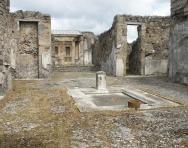

Why is Pompeii so famous?
Pompeii was a Roman town in southern Italy . On 24 August 79AD was buried under volcanic ash and rock following the eruption of the volcano , Mount Vesuvius. Most of the people who lived there were killed.
The town was excavated 1,600 years later and the remains of many items, buildings and people were found in a ‘petrified’ state (as they were at the time of the eruption).
Today Pompeii is a tourist destination where you can walk through the streets of what was once the first-century Roman city of Pompeii .
Top 10 facts
- The 79AD eruption of Mount Vesuvius was the first time the volcano had erupted for 1,800 years. The people of Pompeii didn’t know what a volcano was.
- The initial ‘mushroom’ cloud that shot out from the volcano as a column reached over 20 miles into the air.
- It has been estimated that the pyroclastic flow (molten and ash) from Vesuvius may have moved down the mountain as fast as 450 miles per hour.
- The pyroclastic flow was estimated to be as hot as 1,830°F or 999°C.
- Mount Vesuvius is thought to be one of the most dangerous volcanoes in the world and is the only active volcano on the mainland of Europe.
- The 79AD eruption lasted more than 24 hours.
- The eruption happened the day after the religious festival of Vulcan, who was the Roman god of fire.
- Pompeii was rediscovered in 1748 when builders were constructing a palace for King Charles III.
- Pompeii is a UNESCO Heritage Site , which means it is protected and preserved.
- Mount Vesuvius erupted most recently in 1944, but it wasn’t as powerful as in 79AD. It has a history of having a catastrophic eruption every 2,000 years or so... and it is almost 2,000 years since 79AD...

Boost Your Child's Maths & English Skills!
- Start your child on a tailored learning plan
- Weekly resources added to your plan
- Keep your child's learning on track and boost confidence
Did you know?
- We know so much about the destruction of Pompeii thanks to letters written by a man called Pliny the Younger , who witnessed the eruption. He also spoke to survivors and asked them about their experiences.
- Pompeii wasn’t the only settlement destroyed by Mount Vesuvius’s eruption in 79AD. Herculanium and Torre Annunziata were also destroyed.
- It is thought that of 20,000 inhabitants of Pompeii and 5,000 inhabitants of nearby Herculanium, around 16,000 people died in the destruction of Pompeii . These people didn’t evacuate immediately after the volcano erupted and then became caught by the toxic clouds of volcanic ash and dust and the pyroclastic flow.
- No-one tried to re-build Pompeii after the eruption, as was usual after a natural disaster, because the city had been buried in over 14 feet of ash and the damage was too great.
- The ash that buried the city and its people preserved everything where it was at the time of the disaster. This helps historians to understand a bit more about Roman life as it is a bit like having a snap-shot of the city in 79AD. Archaeologists found cavities or holes around the skeletons of some of the people they found in Pompeii. These holes where were the bodies of these people had once been and by pouring plaster into them, casts of the people have been formed. These casts can be found dotted around Pompeii, showing where these people were when they were hit by the pyroclastic flow.
- The type of eruption from Mount Vesuvius is now known as a Plinian eruption (after Pliny the younger’s description of it). This means that a tall column of extremely hot gases, ash and magma shoots strait up into the sky. A Plinian eruption doesn’t commonly include a lava flow, but is a pyroclastic flow which contains hot steam, rock, ash and dust.
Pompeii gallery:
- Vesuvius in the background
- A cast of a man caught in the eruption
- Vessels found in the ruins
- Columns that remain from destroyed buildings
- A destroyed statue from Pompeii
- Frescos (paintings) inside Pompeii's buildings
- A street in Pompeii
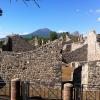
It is thought that people first started to live in Pompeii in the 7th century BC, about 2,700 years ago. Pompeii is found close to the coast where ships could come ashore – a part of modern Italy called the Bay of Naples. The soil was also very fertile which means it was good for growing crops (especially grapes and olives) – this was because volcanic soils are very rich in nutrients. The city didn’t officially become a Roman settlement until 80 BC and at the time was called the Colonia Veneria Cornelia Pompeii. Pompeii was a very popular tourist destination during Roman times and many wealthy people had homes there or went there to visit. It was especially popular because it was a coastal area. It is thought that there were approximately 10,000-20,000 people living in the city. As well as houses, Pompeii had a Roman forum, temples, an aqueduct carrying water for people and a large amphitheatre. The people of Pompeii didn’t know that Mount Vesuvius was a volcano and in fact there wasn’t even a word for volcano in Latin (the language spoken by Romans) as they were not aware of their existence until Vesuvius erupted. Pompeii did experience earthquakes, which scientists today would recognise as a warning that Vesuvius was going to erupt fairly soon, and in 62AD there was a huge earthquake in Pompeii from which the city was still being rebuilt at the time of Mount Vesuvius’s eruption. Mount Vesuvius erupted on 24 August 79AD and it is thought that about 1.5 million tonnes of rock and ash per second created a huge pillar-looking cloud that was over 20 miles up into the sky. The people of Pompeii didn’t know what was happening and didn’t immediately evacuate the city. The cloud began to block out the sun and rock and ash rained down on the city from the volcanic cloud. The people of Pompeii probably thought that if they went outside to leave the city they might get hit by falling rocks (some people tied pillows to their heads to protect themselves), so as a result many stayed put with the aim of sitting it out. Once the debris had stopped falling people went out into the streets and found the city covered in ash, rock and dust. However, what they didn’t realise was that the volcanic ‘mushroom’ cloud was about to collapse in on itself, which would send out what is called a pyroclastic flow. This is a deadly flow of extremely hot gas, rock and ash that moves around 400 miles an hour, destroying everything in its way. Sadly there is no escape from a pyroclastic flow as it travels too fast and is too hot to survive. As a result the people of Pompeii were killed instantly as it arrived in the city and covered them. It is thought that 16,000 people died as a result of the eruption. We know all the details of the events of the eruption because it was witnessed by a man called Pliny the Younger who also spoke to other witnesses before writing down what had happened in two letters to Tacitus, an important Roman historian. After the disaster Pompeii wasn’t rebuilt. The city had been buried in over 14 feet of ash and debris and so was left and eventually forgotten for over 1,600 years. The city was rediscovered in 1748 by builders building a palace for King Charles III. Archaeologists uncovered the city to discover that it had been completed preserved by the ash and that many buildings and artefacts were still in one piece. Holes were also discovered surrounding many of the skeletons found. These holes were where the bodies of these people had lain; by pouring plaster into them the final position of people who had lain there for over 1,600 years could be recreated. Today the city of Pompeii is a tourist site, but is also protected and preserved as a UNESCO Heritage Site. A lot of what we know about Roman life comes from the discovery of Pompeii. Mount Vesuvius is still an active volcano today and will erupt again at some point, although scientists have ways of predicting when this might be. There was an eruption in 1944, but not as huge as the one in 79AD. The surrounding area is still inhabited and Naples is a thriving port city, but were Vesuvius to erupt again all of the people would need to be evacuated very quickly.
Related Videos
Just for fun...
- Play Pompeii Trader to understand what life was like in a busy Roman port and what goods were imported and exported from all across the Roman Empire
- After looking at pictures of the mosaics in Pompeii, including the mosaic of a guard dog , create your own Roman mosaic online
- Take a quiz on Pompeii and test your knowledge
- Plan your own investigation into the events of 79 AD
Children's books about Pompeii

Find out more about Pompeii
- The UNESCO guide to the archaeological areas of Pompei, Herculaneum and Torre Annunziata
- A kids' guide to the events in Pompeii
- Watch this reconstruction of the eruption of Mount Vesuvius
- Take a look at some of the objects recovered from Pompeii and see images of the city's art and architecture
- Watch video clips from the BBC programme, Pompeii: The Mystery of the People Frozen in Time
- Understand more about typical homes in Pompeii
- The disaster at Pompeii was completely unexpected , but could we now prevent it?
- More information about work and play in Pompeii
- Find out more about the discovery and excavation of Pompeii
- Six new homes have recently been restored and opened to the public in Pompeii ; see pictures from the public opening in December 2015
- Join historian Greg Jenner for a kids' HomeSchool Histories lesson on life in Roman Pompeii
- Look through images of some of the beautiful objects found at Pompeii
- Find out why, even today, Vesuvius is the most dangerous volcano in the world
See for yourself
- Experience some 360-degree interactive panoramas of Pompeii and the city of Herculaneum
- If you ever visit Italy , you could visit the city of Pompeii in person and climb up Mount Vesuvius
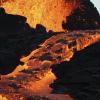
Give your child a headstart
- FREE articles & expert information
- FREE resources & activities
- FREE homework help
Ancient Rome
The city of pompeii.
History >> Ancient Rome

- The eruption occurred one day after the religious festival to Vulcan, the Roman god of fire.
- The amount of energy released by the eruption was roughly one hundred thousands times the thermal energy released by the atomic bomb dropped on Hiroshima.
- The nearby city of Herculaneum was also destroyed.
- Archeologists found holes in the ashes that were once the bodies of people that were buried in the eruption. By pouring plaster into these holes, scientists have been able to make detailed casts of many of the citizens of Pompeii.
- The recovered city of Pompeii is one of the most popular tourist attractions in Italy .
- The city was located around 5 miles from Mount Vesuvius.
- Take a ten question quiz about this page.
- Listen to a recorded reading of this page:
- History Classics
- Your Profile
- Find History on Facebook (Opens in a new window)
- Find History on Twitter (Opens in a new window)
- Find History on YouTube (Opens in a new window)
- Find History on Instagram (Opens in a new window)
- Find History on TikTok (Opens in a new window)
- This Day In History
- History Podcasts
- History Vault
By: History.com Editors
Updated: July 29, 2022 | Original: August 27, 2010

Pompeii, a flourishing resort city south of ancient Rome, was nestled along the coast of Italy in the shadow of Mount Vesuvius, an active volcano. Its most famous eruption took place in the year 79 A.D., when it buried the city of Pompeii under a thick carpet of volcanic ash. The dust “poured across the land” like a flood, one witness wrote, and shrouded the city in “a darkness…like the black of closed and unlighted rooms.” Two thousand people died, and the city was abandoned for almost as many years. When a group of explorers rediscovered the site in 1748, they were surprised to find that beneath a thick layer of dust and debris, Pompeii was mostly intact. The buildings, artifacts and skeletons left behind in the entombed city have taught us a great deal about everyday life in the ancient world.
Where Is Pompeii?
Located on the west coast of Italy along the shores of the Bay of Naples—south of the modern-day city of Naples— ancient Greek settlers made Pompeii part of the Hellenistic sphere in the 8th century B.C. An independent-minded town, Pompeii fell under the influence of Rome in the 2nd century B.C., and eventually the Bay of Naples became an attraction for wealthy vacationers from Rome who relished the Campania coastline.
By the turn of the first century A.D., the town of Pompeii, located about five miles from Mount Vesuvius, was a flourishing resort for the most distinguished citizens of the Roman Empire . Elegant houses and elaborate villas—many filled with exquisite artworks and sparkling fountains—lined the paved streets.
Much of the city’s wealth derived from its rich volcanic soil—the region was a center for olives, grapes and other crops, and wine from Pompeii was enjoyed in some of Rome’s most fashionable houses.
Tourists, townspeople and enslaved people bustled in and out of small factories and artisans’ shops, taverns, cafes, brothels and bathhouses. People gathered in the 20,000-seat arena and lounged in the open-air squares and marketplaces.
On the eve of the fateful eruption in 79 A.D., scholars estimate that there were about 12,000 people living in Pompeii and almost as many in the surrounding region.
Did you know? Mount Vesuvius has not erupted since 1944, but it is still one of the most dangerous volcanoes in the world. Experts believe that another catastrophic eruption is due any day—an almost unfathomable catastrophe, since almost 3 million people live within 20 miles of the volcano’s crater.
Mount Vesuvius
Mount Vesuvius did not form overnight, of course. Vesuvius is part of the Campanian volcanic arc that stretches along the convergence of the African and Eurasian tectonic plates on the Italian peninsula—it been erupting for thousands of years.
Sometime around 1995 B.C., for example, an unusually violent eruption (known today as the “ Avellino eruption ”) shot millions of tons of superheated lava, ash and rocks about 22 miles into the sky. That Bronze Age catastrophe destroyed almost every village, house and farm within 15 miles of the mountain.
Villagers around the volcano had long learned to live with their volatile neighbor. Even after a massive earthquake struck the Campania region in 63 A.D.—a quake that, scientists now understand, offered a warning rumble of the disaster to come—people still flocked to the shores of the Bay of Naples, and Pompeii grew more crowded every year.
Pompeii Eruption
Sixteen years after that telltale earthquake, in either August or October of 79 A.D. , a number of small earthquakes rocked the Pompeii region. The people there shrugged off the temblors since they “were not particularly alarming because they are frequent in Campania,” according to the writer and eyewitness Pliny the Younger.
Then, shortly after noon on that fateful day, Mount Vesuvius erupted again. The blast sent a plume of ash, rock and scorching-hot volcanic gases so high into the sky that people could see it for hundreds of miles around.
Pliny the Younger, who watched the eruption from across the Bay of Naples, compared this “cloud of unusual size and appearance” to a pine tree that “rose to a great height on a sort of trunk and then split off into branches.” (Today, geologists refer to this type of volcanic blast as a “Plinean eruption.”)
As it cooled, this tower of debris drifted to earth: first the fine-grained ash, then the lightweight chunks of pumice and other rocks. It was terrifying—“I believed I was perishing with the world,” Pliny wrote, “and the world with me”—but it was not yet lethal: Most Pompeiians had plenty of time to flee, and many did.
Herculaneum and Pompeii
For those who stayed behind in Pompeii, Herculaneum and other towns, conditions soon grew much worse. As more and more ash fell, it clogged the air, making it difficult to breathe. Buildings collapsed under overloaded roofs, but still some people remained in the city, now covered under several feet of ash.
Then, on the morning of the following day, a “pyroclastic flow”—a 100-miles-per-hour blast of superheated gas and pulverized rock—poured down the side of the mountain and vaporized everything and everyone in its path.
By the time the Vesuvius eruption sputtered to an end on the second day of the eruption, Pompeii was buried under millions of tons of volcanic ash.
Some people drifted back to town in search of lost relatives or belongings, but there was virtually nothing left to find. Pompeii, along with the neighboring town of Herculaneum and a number of villas in the area, was abandoned for centuries.
Pompeii Bodies
About 2,000 Pompeiians died in the city, but the eruption in total killed up to 16,000 people in Pompeii, Herculaneum and other towns and villages in the region.
Bodies of men, women, children and animals were frozen right where they’d fallen—many of the bodies uncovered later were still clutching valuable household objects they’d hoped to carry safely out of the city. Some bodies were found with their arms poignantly wrapped around children or other loved ones.
Later archaeologists even uncovered jars of preserved fruit and loaves of bread. Most of the city’s buildings were intact, and everyday objects and household goods still littered the streets. The powdery volcanic ash that buried Pompeii had proved to be an excellent preservative.
Pompeii Exhibit
Pompeii remained mostly untouched until 1748, when a group of explorers looking for ancient artifacts arrived in Campania and began to dig. They found that the ashes had acted as a marvelous preservative: Underneath all that dust, Pompeii was almost exactly as it had been almost 2,000 years before.
Many scholars cite the excavation of Pompeii as an influence in the neo-Classical revival of the 18th century. Europe’s wealthiest and most fashionable families displayed art and reproductions of objects from the ruins, and drawings of Pompeii’s buildings helped shape the architectural trends of the era.
For example, wealthy British families often built “Etruscan rooms” that mimicked those in Pompeiian villas. Today, many of the preserved artworks, frescoes and other artifacts are on exhibit at the Pompeii Antiquarium , located among the city’s ruins.
The excavation of Pompeii that has been going on for almost three centuries continues today, and the entire site has been declared a UNESCO World Heritage Site. Scholars and tourists remain just as fascinated by the city’s eerie ruins—and the artifacts and bodies buried on that fateful day over 2,000 years ago—as they were in the 18th century.
“Many disasters have befallen the world,” wrote the German philosopher-poet Goethe, after touring Pompeii’s ruins in the 1780s, “but few have brought posterity so much joy.”

HISTORY Vault: Ancient History
From Egypt to Greece, explore fascinating documentaries about the ancient world.
History of Pompeii. Pompeii Online . Antiquarium. Pompeiisites.org . Resurrecting Pompeii. Smithsonian Magazine . Archaeological Areas of Pompei, Herculaneum and Torre Annunziata. UNESCO World Heritage Convention .

Sign up for Inside History
Get HISTORY’s most fascinating stories delivered to your inbox three times a week.
By submitting your information, you agree to receive emails from HISTORY and A+E Networks. You can opt out at any time. You must be 16 years or older and a resident of the United States.
More details : Privacy Notice | Terms of Use | Contact Us
- Skip to primary navigation
- Skip to main content
- Skip to primary sidebar
- Skip to footer
KidsKonnect
Reading Comprehension Cause and Effect Context Clues Compare and Contrast
Noun Worksheets Writing Prompts Compound Words Figurative Language
The Wizard of Oz Hans Christian Andersen Types of Writing Text Structure
Literary Devices
Alliteration Hyperbole Metaphor Irony
Subject Verb Agreement Poetry Climax Rhyme
View all reading worksheets
Action Verbs Tragedy Transition Words Phonics
View all writing worksheets
Dramatic Irony Cacophony Anaphora Setting
View all literature worksheets
Abbreviations Transition Words Conclusion Situational Irony
View all literary device worksheets
Women’s History
Inspirational Women Women's History Month First Lady of the US Women's Equality Day International Women's Day
View all Women's History worksheets
American Revolution
American Revolution Patriots & Loyalists Patrick Henry Sons of Liberty
View all American Revolution worksheets
US Constitution US Independence Trail of Tears The Pilgrims
View all US History worksheets
Ancient History
Ancient China Ancient Mayan Ancient Rome Ancient Aztec
View all Ancient History worksheets
World History
Roaring Twenties Industrial Revolution Middle Ages The Renaissance
View all World History worksheets
Famous Wars
World War 1 World War 2 Vietnam War American Civil War
View all Famous War worksheets
Anne Frank Sally Ride Neil Armstrong Christopher Columbus
View all famous figure worksheets
Joe Biden Donald Trump Abraham Lincoln George Washington
View all President worksheets
Roald Dahl Dr Seuss JK Rowling Michael Morpurgo
View all author worksheets
Civil Rights
Rosa Parks Sojourner Truth Medger Evers Martin Luther King
Elvis Presley Johann Sebastian Bach Ella Fitzgerald Wolfgang Mozart
View all musician worksheets
Thomas Edison Albert Einstein Henry Ford Wright Brothers
View all inventor worksheets
Muhammad Ali Michael Jordan Jackie Robinson Jesse Owens
View all athlete worksheets
Nat Turner Ruby Bridges Harriet Tubman Booker T Washington Malcolm X
View all civil rights worksheets
Natural Wonders
River Nile Mount Everest Sahara Desert Mount Etna Ancient Pyramids Amazon River
Landmarks/Sights
Mount Rushmore Statue Of Liberty White House Stonehenge Great Wall of China Santa Fe Trail
New York Texas South Carolina Alaska Nevada Ohio
Australia United Kingdom China Canada Argentina Brazil
Mount Fuji Mississippi River Rocky Mountains Volcano Glacier The Great Barrier Reef
View all natural wonders worksheets
Hoover Dam Bermuda Triangle Leaning Tower Of Pisa Arc De Triomphe Golden Gate Bridge Colosseum
View all landmark worksheets
California Colorado Indiana Florida Washington Georgia
View all US state worksheets
Poland Greece Philippines Japan France India
View all country worksheets
May Day Cinco de Mayo Teachers’ Appreciation Day Mother’s Day Memorial Day Mexican-American War Lewis and Clark The Tea Act of 1773 Haymarket Square Riot Beltane
View all Seasonal worksheets
Social Emotional Learning
Morals and Values Self Management Ethics Depression Relationship Skills Self-Awareneess Self-Esteem Emotions and Feelings Goal-Setting Interpersonal Skills
View all Social-Emotional Learning worksheets
Celebrations
Easter Saint Patrick’s Day Valentines Day Chinese New Year Rosh Hashanah Thanksgiving Flag Day Cinco de Mayo Beginning Of Lent Yom Kippur View all Celebrations worksheets
Remembrance
Pearl Harbor Day Veterans’ Day Memorial Day Battle Of The Somme D-Day 9/11 Anzac Day Martin Luther King Jr. Day International Women’s Day Victoria Day View all Remembrance worksheets
Camels Fox Bears Penguin Wolf Beavers Mountain Lion Red Panda Snow Leopard White Tigers Silverback Gorilla Okapi
View all mammal worksheets
Marine Life
Crabs Starfish Fish Octopus Great White Shark Dolphin Walrus Narwhal Megalodon Shark Killer Whale Beluga Whale Lionfish
View all marine life worksheets
Insects/Invertebrates/Reptiles
Millipede Praying Mantis Ladybug Ants Spider Iguana Chameleon Komodo Dragon Lizard Bearded Dragon Gila Monster Snakes
View all insect worksheets
Eagle Peregrine Falcon Snowy Owl Emu Woodpecker Albatross Swan Quail Bald Eagle Hummingbird Peacock
View all Bird worksheets
Natural World
Avalanche Flood Tsunami Natural Disasters Fossils Ice Age
View all natural world worksheets
Earth Sciences
Water Cycle Global Warming Deciduous Forests Hurricane Sandy Hurricane Katrina Global Warming
View all earth science worksheets
Food Chain Fossils Photosynthesis Cells Ecosystem Plants
View all biology worksheets
Solar System Black Holes Eclipse Stars and Constellations The Moon Comets
View all space worksheets
Chemistry/Physics
Magnetism Graduated Cylinders Solid, Liquid, Gas Gravity Light Sound
View all science worksheets
Kangaroo Horse Bear Lion Lizard Octopus
View all animal worksheets
Addition Sentences Single Digital Addition Two-Digit Addition Three Digit Addition Repeated Addition
View all Addition Worksheets
Ordinal Numbers Cardinal Numbers Rounding Numbers Odd & Even Numbers Comparing Numbers
View all Numbers Worksheets
Counting Money Subtracting Money Change Money Coin Name & Value Calculate Change (Money)
View all Money Worksheets
Number Line Single Digit Subtraction Place Value Subtraction Sentences Input & Output Tables
View all Math Worksheets
Pompeii Facts & Worksheets
Pompeii was an ancient roman city located in the modern comune of pompeii near naples in the campania region of italy., search for worksheets, download the pompeii facts & worksheets.
Click the button below to get instant access to these worksheets for use in the classroom or at a home.
Download This Worksheet
This download is exclusively for KidsKonnect Premium members! To download this worksheet, click the button below to signup (it only takes a minute) and you'll be brought right back to this page to start the download! Sign Me Up
Edit This Worksheet
Editing resources is available exclusively for KidsKonnect Premium members. To edit this worksheet, click the button below to signup (it only takes a minute) and you'll be brought right back to this page to start editing! Sign Up
This worksheet can be edited by Premium members using the free Google Slides online software. Click the Edit button above to get started.
Download This Sample
This sample is exclusively for KidsKonnect members! To download this worksheet, click the button below to signup for free (it only takes a minute) and you'll be brought right back to this page to start the download! Sign Me Up
Table of Contents
Pompeii was an ancient Roman city located in the modern comune of Pompeii near Naples in the Campania region of Italy. Pompeii, along with Herculaneum and many villas in the surrounding area, was buried under 4 to 6 m of volcanic ash and pumice in the eruption of Mount Vesuvius in AD 79.
See the fact file below for more information on the Pompeii or alternatively, you can download our 20-page Pompeii worksheet pack to utilise within the classroom or home environment.
Key Facts & Information
Description.
- Pompeii is a preserved ancient Roman city in Campania, Italy , 14 miles (23 km) southeast of Naples, at the southeastern base of Mount Vesuvius.
- It was built on a spur formed by a prehistoric lava flow to the north of the mouth of the Sarnus (modern Sarno) River. Pompeii was destroyed, together with Herculaneum, Stabiae, Torre Annunziata, and other communities, by the violent eruption of Mount Vesuvius in 79 CE.
- The circumstances of their destruction preserved their remains as a unique document of Greco-Roman life. Pompeii, Herculaneum, and Torre Annunziata were collectively designated a UNESCO World Heritage site in 1997.
- Pompeii is first mentioned in history in 310 BCE, when, during the Second Samnite War, a Roman fleet landed at the Sarnus port of Pompeii and from there made an unsuccessful attack on the neighboring city of Nuceria.
- At the end of the Samnite wars, Campania became a part of the Roman confederation, and the cities became “allies” of Rome . But they were not completely subjugated and Romanized until the time of the Social War.
- Pompeii joined the Italians in their revolt against Rome in this war and was besieged by the Roman general Lucius Cornelius Sulla in 89 BCE. After the war, Pompeii, along with the rest of Italy south of the Po River, received Roman citizenship.
- However, as a punishment for Pompeii’s part in the war, a colony of Roman veterans was established there under Publius Sulla, the nephew of the Roman general.
- Latin replaced Oscan as the official language, and the city soon became Romanized in institutions, architecture, and culture. A riot in the amphitheatre at Pompeii between the Pompeians and the Nucerians, in 59 CE, is reported by the Roman historian Tacitus.
- An earthquake in 62 CE did great damage in both Pompeii and Herculaneum. The cities had not yet recovered from this catastrophe when final destruction overcame them 17 years later.
MOUNT VESUVIUS
- Vesuvius, in 2013, was 4,203 feet (1,281 meters) tall. After each eruption, the size of the cone changes.
- The volcano also has a semicircular ridge called Mount Somma that rises to 3,714 feet (1,132 m).
- The valley between the cone and Mount Somma is called Valle del Gigante or Giant’s Valley. Mount Vesuvius is considered to be one of the most dangerous volcanoes in the world because of its proximity to the city of Naples and the surrounding towns on the nearby slopes.
- The volcano is classed as a complex stratovolcano because its eruptions typically involve explosive eruptions as well as pyroclastic flows. A pyroclastic flow is a high-density mix of hot lava blocks, pumice, ash, and volcanic gas, according to the U.S. Geological Survey.
- Vesuvius and other Italian volcanoes, such as Campi Flegrei and Stromboli, are part of the Campanian volcanic arc. The Campanian arc sits on a tectonic boundary where the African plate is being subducted beneath the Eurasian plate.
- Under Vesuvius, scientists have detected a tear in the African plate. This “slab window” allows heat from the Earth’s mantle layer to melt the rock of the African plate building up pressure that causes violent explosive eruptions. In the past, Mount Vesuvius has had a roughly 20-year eruption cycle, but the last serious eruption was in 1944.
ARCHAEOLOGICAL RESEARCH
- The extent of the archaeological sites makes them of the greatest importance, for they provide a unique source of information about so many aspects of social, economic, religious, and political life of the ancient world.
- The many well-preserved house shrines give a hitherto unexpected picture of the vitality of religion in the family. The bakeries, complete with mills, kneading machines, and ovens, some still containing loaves of bread, show how this staple of everyday life was produced.
- Pompeii was a busy port town that exported products throughout the Mediterranean region. Merchants and tradesmen found food and lodging near the city gates and the Forum.
CURRENT STATUS
- Since 1944, there have been hundreds of minor earthquakes in the region around Mount Vesuvius. The most serious earthquake rocked Naples in October 1999.
- The magnitude-3.6 quake was felt as far as 15 miles (24 km) from the base of the volcano and was of the same magnitude as a quake that occurred 17 years prior to the last truly major explosion that devastated Naples.
- In 2016, excavations on the outskirts of Pompeii revealed more victims of the volcanic eruption. Archaeologists discovered the remains of four people, including one teenage girl, in the ruins of a shop, according to a statement from the Soprintendenza Pompei, the Italian authority in charge of managing the ancient site.
Pompeii Worksheets
This is a fantastic bundle which includes everything you need to know about the Pompeii across 20 in-depth pages. These are ready-to-use Pompeii worksheets that are perfect for teaching students about the Pompeii which was an ancient Roman city located in the modern comune of Pompeii near Naples in the Campania region of Italy. Pompeii, along with Herculaneum and many villas in the surrounding area, was buried under 4 to 6 m of volcanic ash and pumice in the eruption of Mount Vesuvius in AD 79.
Complete List Of Included Worksheets
- Pompeii in Italy Facts
- Fascinating Facts
- Pompeii Timeline
- When in Italy
- Fix Me! I’m Broken!
- Breaking News!
- Eruption Pic!
- Eruption Hazards!
- Pompeii and the Six Thinking Hats
- Pompeii Essay
Link/cite this page
If you reference any of the content on this page on your own website, please use the code below to cite this page as the original source.
Link will appear as Pompeii Facts & Worksheets: https://kidskonnect.com - KidsKonnect, October 15, 2019
Use With Any Curriculum
These worksheets have been specifically designed for use with any international curriculum. You can use these worksheets as-is, or edit them using Google Slides to make them more specific to your own student ability levels and curriculum standards.
Related Resources
KidsKonnect is a growing library of high-quality, printable worksheets for teachers and homeschoolers.
Home Facts Privacy About Blog Contact Terms
Safe & Secure
We pride ourselves on being a safe website for both teachers and students. KidsKonnect uses a secure SSL connection to encrypt your data and we only work with trusted payment processors Stripe and PayPal.

Sign Up Today
Start your 14 day free trial today

The History Hit Miscellany of Facts, Figures and Fascinating Finds
Pompeii, Campania, Italy
Pompeii was an ancient Roman city whose incredibly well-preserved ruins now form a popular UNESCO World Heritage site.

Sarah Roller
24 jun 2021, @sarahroller8.

About Pompeii
One of the best known ancient sites in the world, Pompeii was an ancient Roman city founded in the 6th to 7th century BC and famously destroyed by the eruption of the volcano Mount Vesuvius in 79 AD.
History of Pompeii
It’s thought Pompeii was established sometime around 450 BC. Following the Social Wars, Pompeii became a Roman colony, and quickly assimilated into the Roman world, adopting Latin as the dominant language and becoming Roman citizens. The fertile soil of the area, combined with the desirability of the Bay of Naples as a location meant that the town grew prosperous and wealthy, becoming a retreat for the wealthy, as well as an important port.
History Hit Holidays

Uncover Pompeii with Sophie Hay and Tristan Hughes
In 62 AD, the area was hit by a major earthquake and a programme of rebuilding was initiated, including the repair and restoration of frescoes and the redesign of some of the major public buildings in the city. Despite this, the archaeological evidence suggests that Pompeii was flourishing at this point, able to afford to rebuild and also complete extra building projects, including new City Baths.
In 79 AD, the town was buried under a layer of lapilli (burning fragments of pumice stone) 6 or 7 metres deep following the eruption of the nearby Mount Vesuvius, Unlike the nearby town of Herculaneum , this meant that the city was buried in motion, and has provided historians and archaeologists with a fascinating glimpse into everyday Roman life, from social conventions and class structures to ancient graffiti.
The full horror Pompeii’s inhabitants must have faced is also apparent – they were buried alive instantly in a wave of super-heated volcanic ash, their faces frozen in screams, their bodies curled up in an attempt to shield themselves. Only just over 1000 body casts were found, suggesting that the majority of the town’s 20,000 inhabitants managed to escape with their valuables in the first 18 hours of the eruption.
Pompeii was ‘rediscovered’ in the 16th century during the digging of a canal, and excavations began in the 18th century. About 2/3rds of the original site has now been excavated, and archaeologists are still working on the remaining areas.
Pompeii today
There’s no denying the world’s enduring fascination with Pompeii – to say it’s like stepping back in time is something of a cliche, but in the case of Pompeii, it’s hard to describe the experience in any other way. There’s a sense that you’re intruding on a different world – houses, temples, shops, cafes and even a brothel are all visible today, in amazingly good condition. Some of the frescoes found are phenomenal.
Expect to spend at least half a day wandering – wear comfy shoes and it’s sensible to invest in an audio guide (albeit at additional cost) in order to understand and appreciate where you are, and what function some of the buildings and areas served in Roman life. A hat is also a must in the summer as there’s limited shade and it can get extremely hot. During the summer, the Pompeii Archaeological Superintendence organises evening tours.
Amongst Pompeii’s most interesting sites are; the public marketplace or ’Forum’, a large home known as the House of the Vettii and the Basilica, which was a central building in the city. The artefacts found at the site are also fascinating, with many domestic objects and even the preserved bodies of people who perished in the eruption.
Pompeii Amphitheatre is also staggeringly impressive, it being a 20,000 seat structure and the first ever stone amphitheatre. In 59AD, the Emperor Nero banned games in this sports venue for a whole ten years, after a giant brawl between fans of Pompeii and those of neighbouring Nuceria.
Many of the finds from Pompeii are housed in the Naples Archaeological Museum .
Getting to Pompeii
Pompei is a modern day Italian town: there’s a train station with regular departures to Salerno and Torre Annunziata, where you’ll need to change trains if you’re heading to or from Naples, or you can stop at Pompei Scavi, which is on the mainline between Naples and Sorrento, and is much closer to the archaeological site itself. Buses 5000 and 5020 also run from Naples and stop in the centre of town.
The archaeological site is just off the E45 and SS18 if you’re heading into Pompei: there’s some parking nearby but it gets extremely busy. Pompeii is about a 25 minute drive or a 35 minute train from Naples.
Featured In

Incredible Ancient Ruins for Historic Photography
Looking for inspiration for your next photo project? Explore some of the most breathtaking and photogenic ancient ruins with this list.

Ancient Cities to Visit
Discover ancient history: these 15 metropolises, from the ruins of Pompeii to the mountainous Machu Picchu, are must-visit relics of the ancient world.

Roman Sites in Italy
A guide to the very best Ancient Roman sites in Italy, featuring the infamous Pantheon and Colosseum in Rome to Herculaneum on the stunning Amalfi Coast.

Roman Temples
Discover incredible Roman temples you can still visit today, from Baalbek to the Pantheon and more, includes an interactive map of surviving temples from ancient rome.

Related Articles

10 Great Warrior Women of the Ancient World

What Caused Boudicca’s Great British Revolt Against Roman Rule?
Watch and listen.

The Julio-Claudians

Killing God: The Assassination of Julius Caesar
You may also like.

10 Key Historic Sites to See in Rome
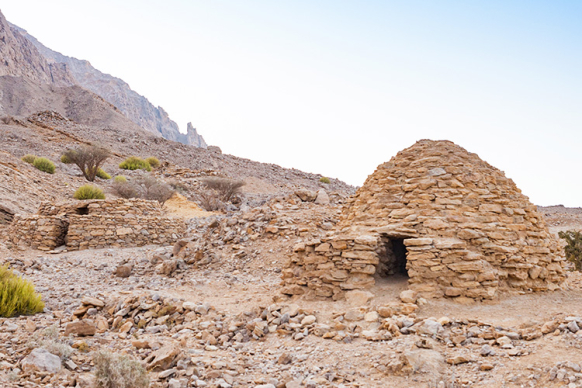
The 10 Best Bronze Age Sites to Visit in the World

5 Haunted Sites to Explore in Venice

The 5 Best Historic Sites in Venice
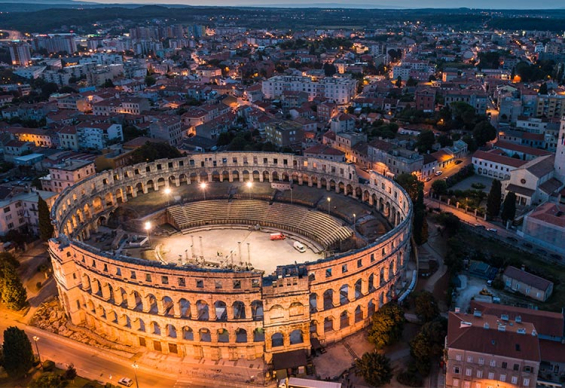
10 Historic Sites You Should Not Miss in 2023

The 10 Most Significant Italian Cathedrals

The 8 Best UNESCO World Heritage Cities

The Top 10 UNESCO World Heritage Sites

10 of the Oldest Churches in the World

10 of the Oldest Hotels in the World

The Top Historic Spa Towns to Visit in Europe

12 of the Most Haunted Hotels in the World

15 of the Most Haunted Places in the World

12 Eerie Cemeteries to Visit Around the World

- Ancient History
Pompeii Lesson

Learning objectives
In this lesson, students will gain an understanding of the archaeological site of Pompeii. They will develop an awareness of the key people, events, and concepts associated with this movement. Students will have the opportunity to achieve this through choosing their own method of learning, from source analysis, research, and video options, as well as the chance to engage in extension activities. This lesson includes a self-marking quiz for students to demonstrate their learning.
How would you like to learn?
Option 1: reading.
Step 1: Download a copy of the reading questions worksheet below:
Step 2: Answer the set questions by reading the following web page:

Option 2: Using sources
Step 1: Download a copy of the source analysis worksheet below:
Step 2: Answer the set questions by reading the following sources:

Option 3: Internet research
Download a copy of the research worksheet and use the internet to complete the tables.
Option 4: Watch video
Step 1: Download a copy of the viewing questions worksheet:
Step 2: Answer the set questions by watching the documentary below:

Odyssey - Ancient History Documentaries. (2021). What Happened The Day Pompeii Died?
Watch on YouTube

Test your learning
Extension activities, resources for subscribers.

What do you need help with?
Download ready-to-use digital learning resources.

Copyright © History Skills 2014-2024.
Contact via email
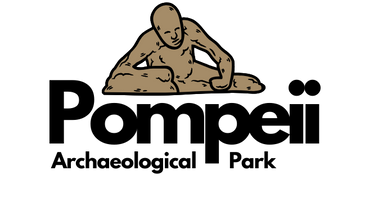
History of Pompeii: A Comprehensive Guide to the Lost City of the Ancient Romans
Table of contents, introduction.
Pompeii, once a bustling Roman city, was abruptly frozen in time in the year AD 79 by the eruption of Mount Vesuvius. Rediscovered in the 18th century, it has since become an evocative and invaluable archaeological site, capturing the imaginations of artists, scholars, and tourists for centuries.
This comprehensive guide is designed to take you deep into the history and significance of Pompeii, offering a detailed exploration of its impact on the past and present. Whether you’re planning a visit, studying the ancient world, or simply fascinated by history, this guide serves as your personal passport back in time.
The Majestic History of Pompeii
Pompeii, before the fateful eruption of Mount Vesuvius, was a bustling city in the shadow of the famed volcano. With its advanced infrastructure, grand villas, and a culturally-rich urban society, Pompeii was a jewel of the Roman Empire.
The catastrophic eruption on August 24th, in AD 79, brought ash, pumice, and fear, enveloping the city and its unsuspecting inhabitants. A testament to the power of nature and a unique historical document, the perfectly-preserved ruins of Pompeii have unlocked profound insights into ancient Roman life.
The city’s remains have withstood the relentless passage of time to provide a vivid snapshot of that bygone era. From street markets to the amphitheater, the artifacts and structures offer an unparalleled opportunity to walk the cobbled streets of history of Pompeii.
The Rediscovery of Pompeii and Its Archaeological Resurgence

The history of Pompeii’s rediscovery is as compelling as the city itself. A chance discovery during the construction of a new palace in 1748 brought the ruins to light after nearly 1700 years. This monumental finding led to extensive excavation and the emergence of advanced archaeological techniques that changed the field forever.
The early explorers of Pompeii, namely Karl Weber, Giuseppe Fiorelli, and Amedeo Maiuri, enacted a shift from treasure hunting to systematic, scientific excavations. Their efforts were met with both international acclaim and scholarly debate, illustrating the complexities of preserving and interpreting such an extensive site.
Technological Marvels in Pompeii’s Archaeological Digs
Excavating a city as intricate as Pompeii required innovation. The scientists and archaeologists who turned their attention to the site developed new methods to uncover and understand its secrets.
Perhaps the most iconic of these innovations is the plaster casting technique, which involved pouring plaster into the cavities left by decomposed bodies, preserving the contours of their last moments.
This method and others like it have brought the ruins to life, providing poignant visual evidence of how the disaster unfolded. Yet, with innovation came controversy, as some historians and conservationists questioned the ethics and necessity of these aggressive techniques.
Preserving the Timeless Elegance of Pompeii
Despite the extraordinary preservation of Pompeii, the ancient city faces ongoing threats from both nature and humanity. Encroaching modern developments, weathering from the elements, and the dissociative impacts of tourism are challenges to the site’s structural integrity and historical significance.
Authorities have implemented a variety of strategies to mitigate these risks. From conservation efforts that focus on strengthening the ruins to balancing both preservation and public access, Pompeii presents a unique challenge to those tasked with safeguarding it for future generations.
Social Symphonies Through Pompeii’s Artifacts

The artifacts of Pompeii do not merely replicate life; they narrate it. A stroll through the city’s museum reveals a poignant story about the inhabitants of Pompeii. Frescoes, mosaics, and domestic objects portray the day-to-day existence and spiritual life of the residents.
Cherished keepsakes, discarded possessions, and the remnants of public buildings provide an intimate look at the society that thrived in the shadow of Vesuvius. On closer examination, it becomes apparent that the voices of Pompeii’s past resonate with timeless themes that remain relevant today.
Erotic Art and the Complex Threads of Cultural Norms
The presence of erotic art in Pompeii has captivated modern imagination and lent an air of mystery to the city’s cultural identity. Though the erotic frescoes and statues found in Pompeii and its sister city Herculaneum have been branded as scandalous by some, they paint an intriguing picture of Roman perspectives on sexuality and artistry.
The exploration of these works is more than an indulgence in voyeurism; it is a lens through which we can gain a deeper understanding of the complex interplay between taboo, tolerance, and artistic expression in ancient Rome.
Pompeii’s Enduring Mark on Contemporary Culture
The legacy of Pompeii extends far beyond the volcanic threshold that once entombed it. From literature to film, the city continues to inspire creative works that transcend time. Its aesthetic, drama, and the profound tragedy of its end have been a wellspring for artists seeking to capture the essence of its spectacle and the human stories within it.
The significant role Pompeii plays in shaping modern Italian culture, providing an anchor for regional identity, and drawing countless scholars and tourists underscores its continued relevance in contemporary society.
The Natural Disaster Narrative and Lessons from Pompeii

Pompeii is a direct link to the past, serving as a harrowing reminder of the capriciousness of nature. The disaster that befell the city holds critical implications for our understanding of volcanism, disaster management, and resilience.
Modern science benefits from the study of Pompeii, honing predictive models and emergency responses based on the tragic events of antiquity.
In commemoration of Pompeii, contemporary disaster preparedness is replete with lessons from the past, ensuring that the city not only remains a treasure trove of ancient knowledge but also a fountain of modern wisdom.
Fiorelli’s Forethought and Legacy in the Restoration of Pompeii
The legacy of Giuseppe Fiorelli extends beyond his innovative approaches to archaeology at Pompeii. His contributions have become fundamental to how we approach the study and preservation of ancient sites.
Fiorelli’s grid system for excavation, meticulous documentation practices, and the plaster casting technique represent a lasting impact on the field of archaeology and conservation.
His work in Pompeii set a standard for future generations of archaeologists and engendered a renewed respect for the importance of methodical inquiry and comprehensive record-keeping as cornerstones of the discipline.
Tourism, Trade, and the Fragile Economy of Pompeii

Pompeii’s ark is laden with history, but its corridors resound with the footfalls of modern tourists. The site’s popularity as a travel destination feeds the local economy while also placing a weighty burden on the delicate remains.
The challenge is to manage the influx of visitors so that the ancient city can continue to contribute to the region’s prosperity without compromising its survival.
The convergence of commerce and history of Pompeii is a microcosm of the broader tension between preservation and progress, underscoring the need for sustainable tourism practices that honor the past without eroding its foundations.
The Endless Exploration of Pompeii’s Patina
In layers of ash and history of Pompeii remains an enigma . It is a living museum, continuously offering new discoveries and insights into the world of our forebears. On your personal voyage to explore the lost city of Pompeii, remember that the path to the past is laden with complexities and responsibilities.
Whether you visit Pompeii in person or through the lens of scholarship, its lessons endure, echoing through the ages and into the hearts of all who stand in its shadow.

- DIGITAL MAGAZINE
MOST POPULAR
Lost city of Pompeii primary resource
Discover what happened when mount vesuvius erupted.
This primary resource introduces children to the Ancient Roman city of Pompeii. Discover what happened when the Mount Vesuvius volcano erupted. When did excavations of the site begin? What warning signs are scientists monitoring for around the volcano today? How have scientists been able to recreate what happened in Pompeii in August A.D. 79?
Pupils will learn about how and what the ash from the volcano preserved from the ancient city in our National Geographic Kids’ Romans primary resource sheet.
The teaching resource can be used in study group tasks for learning more about the day the volcano erupted, as a printed handout for each pupil to review and annotate, or for display on the interactive whiteboard for class discussion.
Activity: Ask children to choose one of the subheadings in the resource and use the information and their own research to create their own comic strip based on that topic. They could also design their own statues of the Roman gods mentioned, in the style of the photographs shown in the resource.
N.B. The following information for mapping the resource documents to the school curriculum is specifically tailored to the English National Curriculum and Scottish Curriculum for Excellence . We are currently working to bring specifically tailored curriculum resource links for our other territories; including South Africa , Australia and New Zealand . If you have any queries about our upcoming curriculum resource links, please email: [email protected]
This primary resource assists with teaching the following Key Stage 2 History objectives from the National Curriculum :
- Pupils should be taught about: the Roman Empire and its impact on Britain
And the following Key Stage 2 Geography objectives from the National Curriculum :
Pupils should be taught to:
- describe and understand key aspects of: physical geography, including: climate zones, biomes and vegetation belts, rivers, mountains, volcanoes and earthquakes, and the water cycle
This primary resource assists with teaching the following Social Studies Second level objective from the Scottish Curriculum for Excellence :
- I can discuss why people and events from a particular time in the past were important, placing them within a historical sequence
- I can compare and contrast a society in the past with my own and contribute to a discussion of the similarities and differences<
- I can describe the physical processes of a natural disaster and discuss its impact on people and the landscape
Scottish Curriculum for Excellence Third level Social Studies objective :
- Having investigated processes which form and shape landscapes, I can explain their impact on selected landscapes in Scotland, Europe and beyond.
- I can identify the possible consequences of an environmental issue and make informed suggestions about ways to manage the impact.
Scottish Curriculum for Excellence Fourth level Social Studies objective:
- I can explain how the interaction of physical systems shaped and continue to shape the Earth’s surface by assessing their impact on contrasting landscape types.
Download primary resource
Leave a comment.
Your comment will be checked and approved shortly.
WELL DONE, YOUR COMMENT HAS BEEN ADDED!
that's interesting, like really!
CUSTOMIZE YOUR AVATAR

Evanna Lynch World Elephant Day interview!
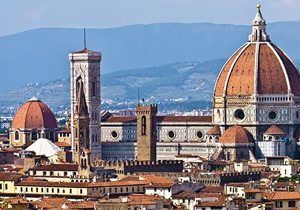
Italy facts: check out this beautiful country!

Are you an eager explorer?
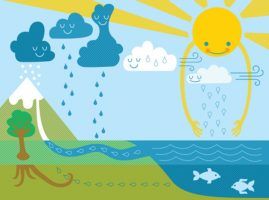
The Water Cycle!

Sign up to our newsletter
Get uplifting news, exclusive offers, inspiring stories and activities to help you and your family explore and learn delivered straight to your inbox.
You will receive our UK newsletter. Change region
WHERE DO YOU LIVE?
COUNTRY * Australia Ireland New Zealand United Kingdom Other
By entering your email address you agree to our Terms of Use and Privacy Policy and will receive emails from us about news, offers, activities and partner offers.
You're all signed up! Back to subscription site
Type whatever you want to search
More Results

You’re leaving natgeokids.com to visit another website!
Ask a parent or guardian to check it out first and remember to stay safe online.

You're leaving our kids' pages to visit a page for grown-ups!
Be sure to check if your parent or guardian is okay with this first.
- Top Destinations
- Mexico City, Mexico
- Tokyo, Japan
- Paris, France
- Rome, Italy
- London, United Kingdom
- All Destinations
- Upcoming Experiences
- Walking Tours
- Small-Group Tours
- Tours for Kids
- Museum Tours
- Food, Wine and Market Tours
- Newly Added Tours
- Audio Guides
- Pre-Trip Lectures
- Admin Dashboard
- My Favorites
- Cookies Preferences
- Client Orders
- Monthly Commissions
- My Advisor Profile
- Advisor Toolkit
- Guide Dashboard
Credit Balance
Transactions are based on current exchange rates and performed in USD. There maybe slight variations in the price estimates.
12 Surprising Pompeii Facts You Need To Know - Especially Before You Go
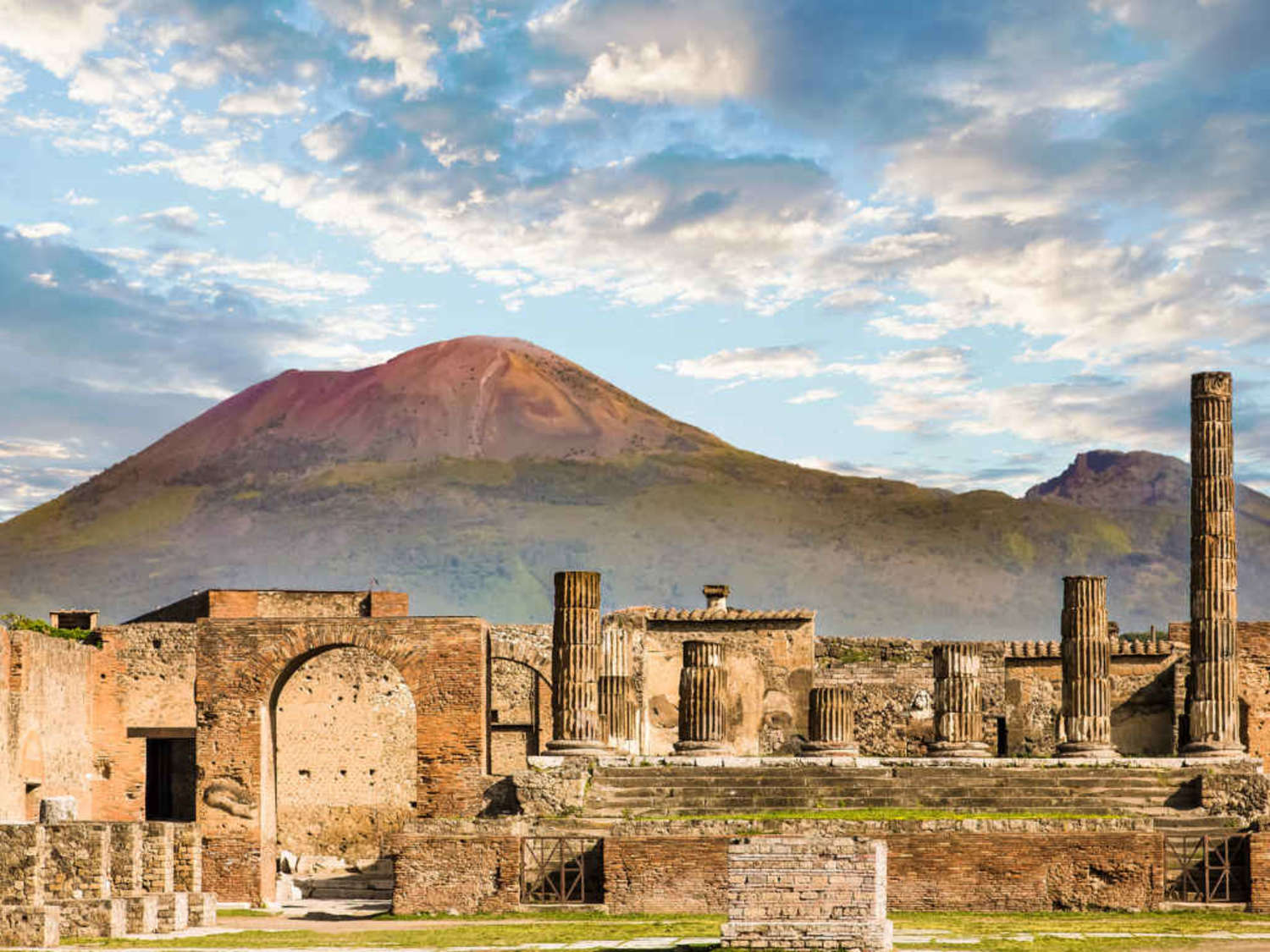
Pompeii with Context: spend a day in Pompeii with an archeologist or a classical historian
A city forever frozen in time, Pompeii’s history is a melancholy paradox. The very event that gruesomely took Pompeii — Mt. Vesuvius’ eruption in 79 AD — preserved the daily comings and goings of the ancient city, allowing us to piece together its story. Excavations through history have given us touching images of an unavoidable tragedy, and reactions of the Roman people right up to their last moments; lovers in an embrace, hurried escapes, bread still in the oven.
While devastating, it is pretty remarkable how we can still very much feel the bustling city of Pompeii. Stand in the middle of this Roman wonder, and you’ll be transported back 2,000 years. You might see the stepping stones used by Pompeians to avoid dirty debris and rain on the streets. On this same street, you might notice marks made by the wheels of chariots, owned by a wealthy resident. Walk through Pompeii, and you’ll notice a city not unlike yours — bakeries, markets, courtyards, graffiti, and murals.
For a city that lived so long ago, teeming with people that feel so distant from us, you might be surprised at how much we have in common with them. If you're ready see Pompeii and Mt. Vesuvius, check out Context experiences in Naples .
Until then, we’ll let these mind-boggling facts guide the way.
1. Pompeii was a lavish city home to wealthy residents and luxurious buildings, villas, decor + artwork

An excavation at Regio V uncovered Vicolo dei Balconi, an area of Pompeii that boasted impressive houses (some with balconies included). Archeologists also found coins, thoroughbred horses with bronze and iron accessories, and well-preserved frescoes and murals of mythological characters. Many of these artworks, like the renowned Sapphos painting, are located in the Archeological Museum of Naples .
Of course, a city full of lavishness can’t be without its vices. Brothels and gambling artifacts were also procured at excavation sites.
2. August 24th may not be Pompeii's actual eruption date
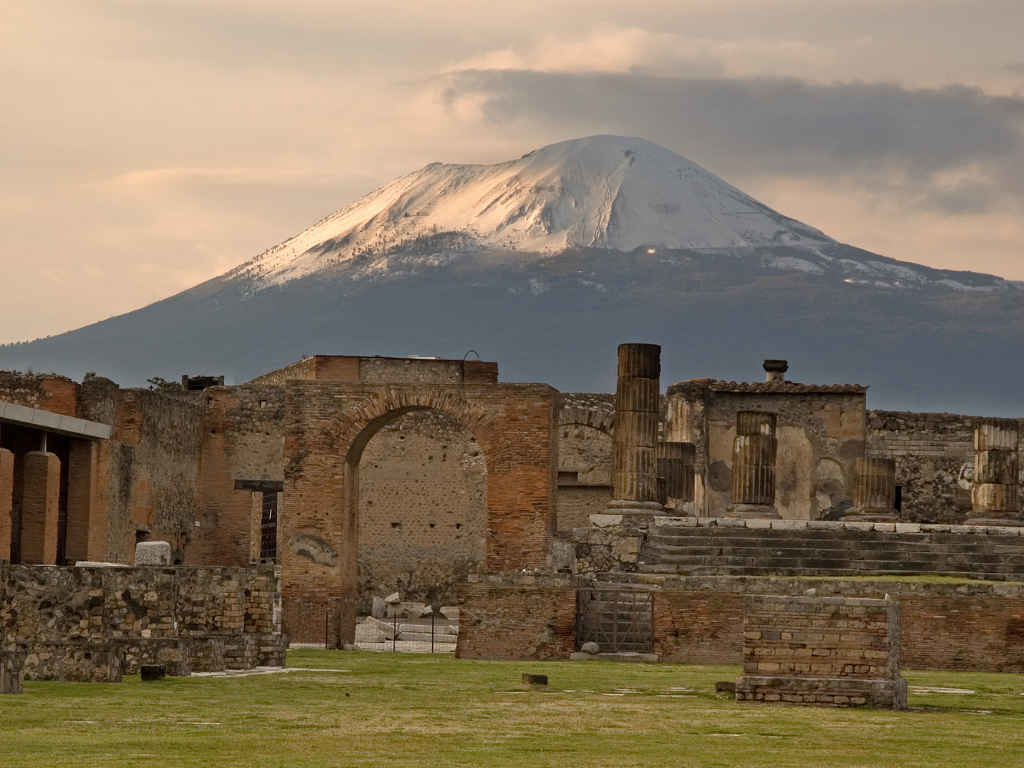
Before recent findings, August 24th 79 AD was thought to be the exact date Pompeii’s eruption occurred. Not so! The widely held belief has been disproved by curious finds that allude to a more autumnal setting. Market stalls that held common fall foods like chestnuts, unripe pomegranates, and harvested wine, as well as other findings like warmer clothing on the Roman people, heaters, and inscriptions all date the event closer to October or November.
3. The soil in Pompeii was black
The eruption at Mt. Vesuvius that decimated Pompeii on that fateful day certainly wasn’t its first, nor would it be its last (more on that later). Farmers that tilled the fertile earth may have sensed the foreshadowing of the city’s imminent demise as the black soil was indicative of earlier eruptions from the volcano.
4. Pompeii was a cosmopolitan city where the Greek language was potentially used alongside Latin
A skeletal analysis at a burial site in Pompeii found a 60ish-year-old man who was thought to have spoken Greek in theatre performances. This could be evidence of a more cosmopolitan landscape in the ancient city with different ethnicities congregating together.
Did you know that Greece had its own version of Pompeii’s eruption from the Santorini Volcano? Learn more here .
5. The people of Pompeii had fantastic teeth
True to the politicians that some of them were, the people of Pompeii had stunning smiles. Their secret? A fiber-rich, low-sugar diet that prevented cavities and kept those gums healthy. Also found at the Vicolo dei Balconi were amphorae, vessels made out of terra-cotta that were used to contain wine, oil, and garum (fermented fish intestines). Save yourself a trip to the dentist and learn from the Pompeians.
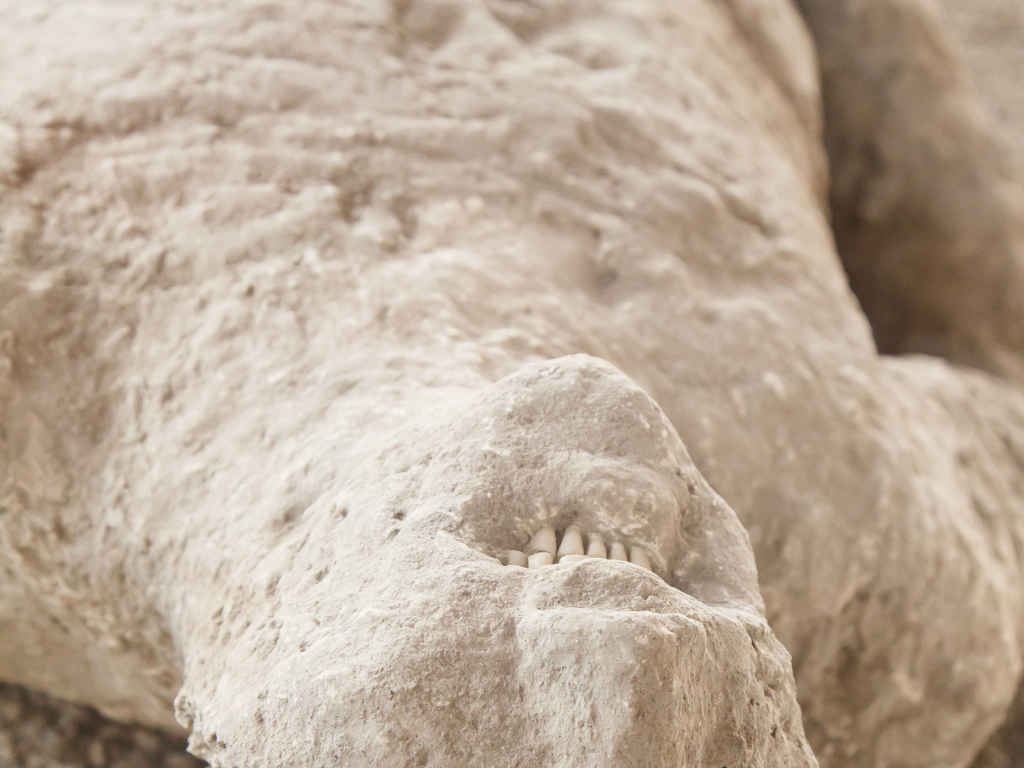
6. These Romans in Pompeii loved to go out to eat
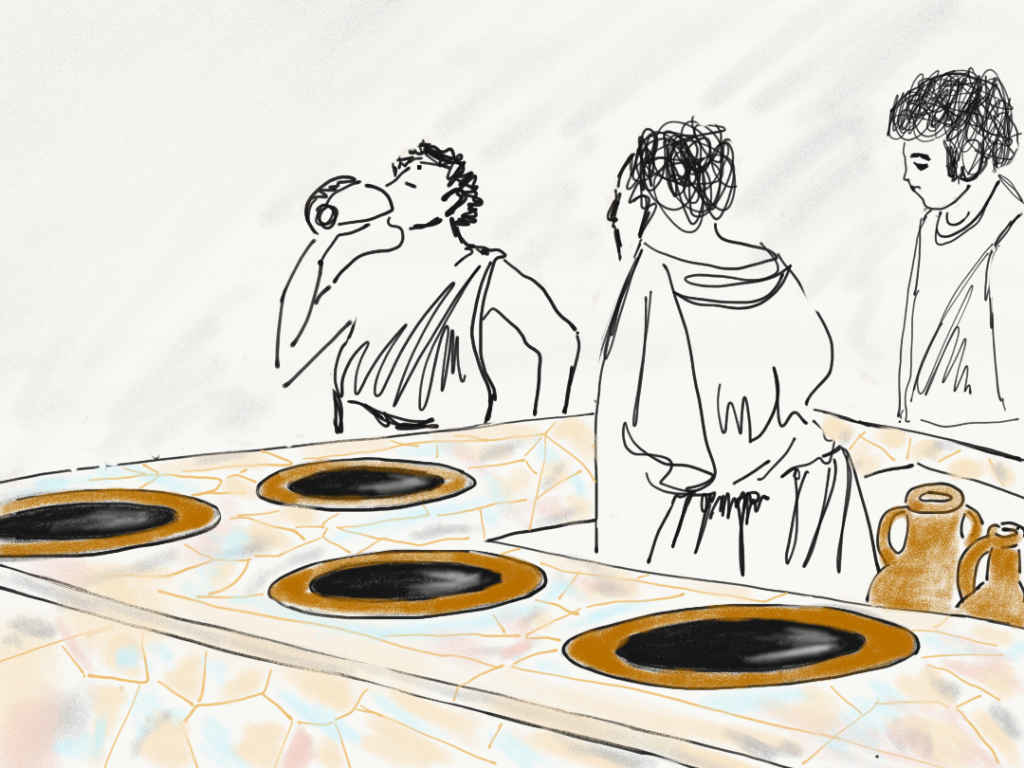
Known for their affinity for wine, cheese, and olive oil, Romans and their fine dining may not be as surprising of a fact, but it is uncanny to feel a certain kinship with their eating habits.

According to our expert on Pompeii’s history, Fiorella Squillante, it was common for people to eat out for their midday meal at what were called thermopolia, or snack bars. A thermopolium is a counter that opened out onto the street with big jars containing food and drinks. One of them has been recently available to the public! See them yourself on a half day tour of Pompeii or at your own pace with our Pompeii Audio Guide .
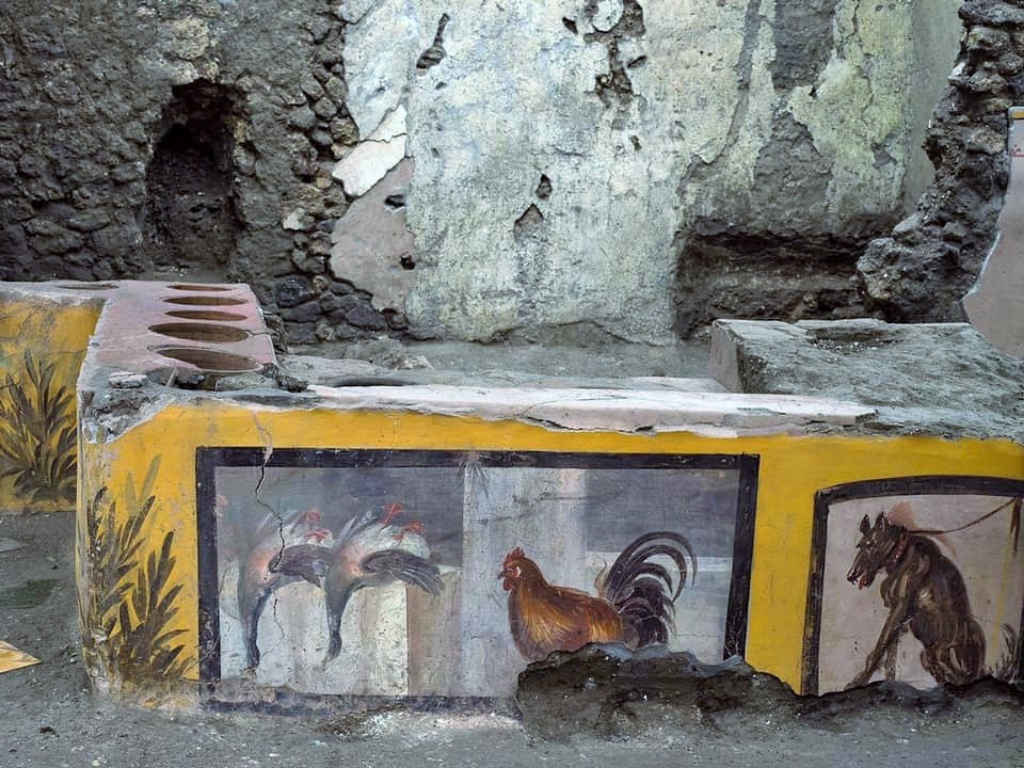
7. The gruesome realities of a volcanic eruption
By now, you know about the city covered in the volcanic ashes of a deadly eruption at Pompeii, preserving (almost too well) the narrative of a city. But what are the details of that narrative? We’ll outline one gruesome story below.

One set of skeletal remains of a man indicate that he was beheaded while escaping the molten heat. Originally, researchers believed that this man was hit by a flying rock. Upon further inspection, they deduced from a limp in his leg that he actually may have stayed home, dying instead by lethal gases. The flying rock could have been a doorjamb propelled by a strong volcanic cloud.

8. The nearby Herculaneum was also impacted by Mt. Vesuvius
Herculaneum was also a vibrant city at the foot of Mt. Vesuvius. With rich villas and luxurious baths, the city of about 5,000 inhabitants was a summertime destination by Romans. It was actually discovered before Pompeii in 1709 (Pompeii was discovered in 1748). Learn more about Herculaneum and Mt. Vesuvius on our full day archaeology tour in Naples.
9. What we know of Pompeii came from letters by Pliny the Younger
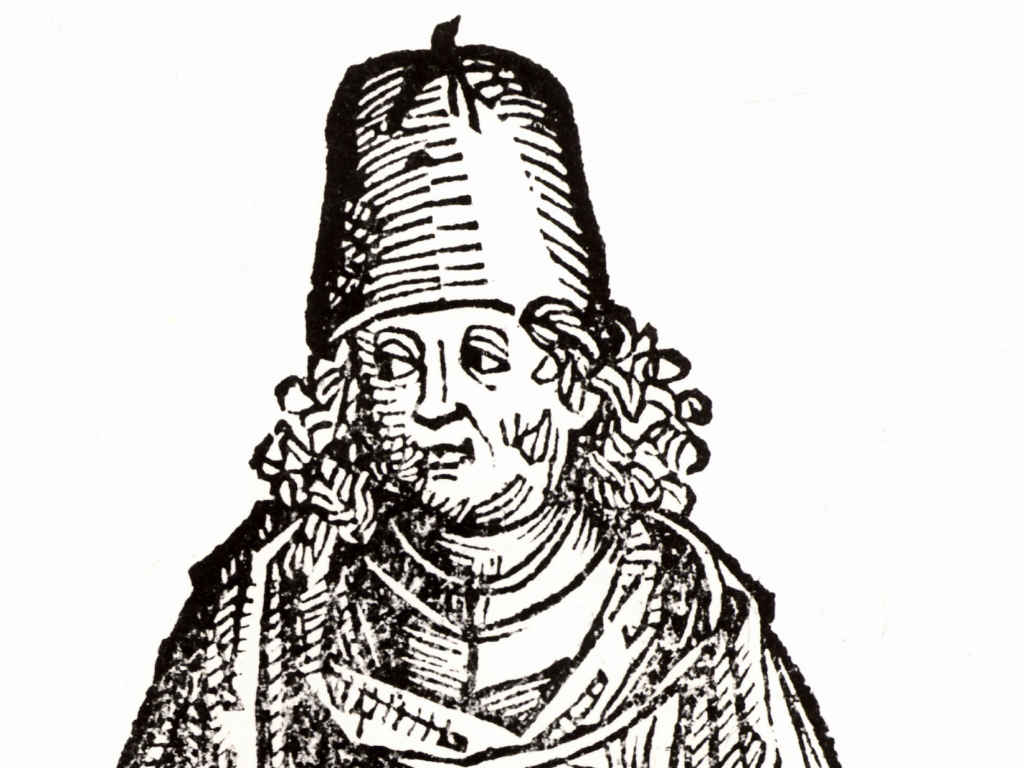
Before recent excavations, what we knew of Pompeii came from letters from Pliny the Younger, a 17-year-old boy who lived along the Bay of Naples at the time of the eruption. The letters were addressed to a historian named Tacitus and they detailed the horrific events that occurred. Pliny the Younger wrote about Romans defending themselves by covering their heads, the awful toxic cloud, wails and prayers, and other events that occurred.
10. His uncle, the famous Pliny the Elder, was a commanding officer and helped in escape efforts
A commander of the Roman fleet, the heroic officer used his boats to see what was going on at Mt. Vesuvius and to mitigate the ensuing panic, but he unfortunately died from toxic gases.

11. Between 79 AD and 1944, Mt. Vesuvius experienced 27 serious eruptions
Far from dormant, the deadly volcano poses a threat to nearby civilization to this day. The last eruption was in 1944. Even though it was a particularly stressful time for chaos (being four years into World War II), residents of the nearby San Sebastiano village and Allied soldiers acted quickly to evacuate. While there were no military deaths, 26 Italian civilians were killed and almost 12,000 people were displaced.
12. The last major Mt. Vesuvius eruption was in 1631
The last major eruption of Mt. Vesuvius wasn’t nearly as fatal as the one during Pompeii’s time, however, it took nearly 3,000 to 6,0000 lives and triggered multiple earthquakes as well as a tsunami.
Traveling soon?
Get a comprehensive view of Naples and beyond with on a Context experience and get to know the city on a walking tour , audio guide , or pre-trip lecture .
Other blogs you may be interested in:
- 12 Things to Do in Naples, Italy: For Day Trips, Weekends and Longer Stays
- The 5 Best Cities to Visit in Italy During Christmas (+ Food and Traditions You Don't Want to Miss!)
- Food Culture of the Italian Renaissance
Tours you'll want to check out:
- Half Day Tour of Pompeii
- Full-Day Archaeology Tour: Mt. Vesuvius
- Pompeii Full Day Excursion (from Naples)
- Archaeological Museum of Naples
- Full Day Pompeii Tour for Kids
Read More Stories

Even More from Context
Subscribe to our Newsletter
Keep Exploring

Explore Tours
Join walking tours with top experts all over the globe.
Browse Our Cities
- Our Experts
- Working with Context
- View All Cities
- Sustainable Tourism
- Refer a Friend for $50
- Travel Updates
- Advisor Login
- Expert Portal
- Privacy Statement & Security
- Cancellation Policy
Mum's Little Explorers
Melbourne for Kids - Activities & Family Travel Ideas
- Italy With Kids
Visiting Pompeii with kids – Including Fun Facts
by mumslittleexplorers · June 12, 2021
Heading to the famous Pompeii ruins in Italy sometime soon? Or just curious about Pompeii? This guide gives you a list of Pompeii facts for kids to learn before you go and visit one of Italy’s most famous attractions. And if you are planning on visiting the Pompeii with kids, you will also find some helpful tips for your trip.

Pompeii, Italy
Pompeii, an ancient Roman city located at the base of Mt. Vesuvius in Italy, is one of the most popular travel destinations in the world today.
Despite what a lot of people might tell you, Pompeii makes for an interesting trip with kids and family. If you do it right, it can be a rich and enlightening experience for the younger ones.
However, it helps to be prepared before you make this trip. Knowing where to find what and being aware of what lanes to steer clear of makes your family trip to Pompeii all the more enjoyable.
Our child-friendly guide of the Pompeii ruins will help you make the most of your family trip.
Find below the following information:
- Brief history of Pompeii
Interesting facts about Pompeii
- Tips for making your visit to Pompeii with kids interesting
- Practical information about your visit including location, cost etc.
Pompeii Facts for Kids
Find below a brief history of Pompeii, and some some facts about the Pompeii for kids.
Brief History of Pompeii
Pompeii was a prosperous Roman town located near modern day Naples. It was filled with exquisitely decorated villas, beautiful monuments, and well-maintained gardens in its heyday.
Not hard to believe that it was a popular vacation destination for wealthy Romans.
Unfortunately, not everything good lasts forever. On the 24 th of August, AD 79, Pompeii was completely buried under volcanic ash from the eruption of Mt. Vesuvius nearby.
More than 10,000 people living in Pompeii were caught off guard and ran for their lives. Not all of them could make it out alive.
A thick layer of ash enveloped the entire city. The thriving life of Pompeii was lost to the world for many centuries after that.
Pompeii, Frozen in time
High heat and molten lava caused Pompeii to be caught in a time warp. People were frozen in whatever position they were in. Ironically, the eruption of Vesuvius preserved the city of Pompeii very well.
Pompeii was accorded the UNESCO heritage status in 1997 because of the complete and unique picture it provides of life in those times.
The House of the Faun, the Villa of Mysteries, a large theater, and the Garden of Fugitives are some of the iconic remnants of Pompeii’s past. Extremely well-preserved ruins, frescoes, and other archaeological remains make Pompeii an excellent destination to experience Roman history.

- Mt. Vesuvius erupted in AD 79 that is nearly 2000 years ago from today.
- More than 10,000 people lived in Pompeii during the eruption. Some of them were able to escape. However, not all were lucky.
- Because of multiple layers of ash that covered Pompeii, the city was caught in a time capsule. The ash actually helped preserve buildings, artwork, even jars of fruit, and loaves of bread.
- Human plaster casts are the most famous and recognisable artefacts of Pompeii.
- Even before the eruption of Mt. Vesuvius, Pompeii had been shaken by multiple earthquakes. The one in AD 62 was particularly destructive.
- Today, Pompeii is one of the most popular tourist destinations in Italy. It attracts more than 2.5 million tourists every year.
Tips for making Pompeii fun and engaging for your kids
A trip to Pompeii is like traveling back in time. A little pre-reading can help children imagine life from 2000 years ago. And ancient houses, shops, eateries, and a stadium perfectly aid this learning process.
With these little tips and tricks, you can make Pompeii an enriching experience for those curious, young minds.
- Book a kid-friendly tour guide to help you glide through the many mazes and lanes of Pompeii. A knowledgeable guide will know just the right stuff to bring the city back to life for the young ones.
- Pompeii is huge. Chart out a plan beforehand on the places you would really want to see and those that can be missed in the paucity of time.
- You will want to avoid the brothels at Pompeii if you are traveling with kids. These places have some really elaborate murals that the kids don’t need to see.
- It can get unbearably hot during the day. And there is hardly any shade at Pompeii. Make sure you carry some snacks, water, hats, and sunscreen. Even better, go early in the morning or later in the day.
- The bumpy Roman roads of Pompeii cannot handle a stroller. Even though there is a small wheelchair trail, it is advisable to bring a baby carrier if you are planning to see a good bit of Pompeii.
Practical Information
Now for the more practical information to help you navigate your way there.
How to get to Pompeii?
Pompeii is quite close to Naples (only 25 km). So, you can easily do a day trip to Pompeii from here. A drive takes only about 30 minutes.
If you are driving in from Rome, it can easily take 3 hours for you to get to the Pompeii archaeological area. A day trip from Rome is still doable if you really want to see it. It will just be a long day.
If you are not driving, the easiest way to get to Pompeii is by using the Circumvesuviana train that runs between Naples and Sorrento. Get off at the Pompeii Scavi/Villa dei Misteri station and walk 5 minutes to get to Pompeii’s main entrance at Porta Marina.
Big bags and backpacks are not allowed inside Pompeii. Remember to check in your baggage at the site entrance or the train station.
What are the opening hours?
Pompeii is open between 9 am – 7:30 pm every Monday to Friday between 1 st April – 31 st October. It opens at 8:30 am on Saturdays and Sundays. Last admission is at 6 pm.
Opening hours in winter (1 st November – 31 st March) are between 9 am to 5 pm. Last admission is at 3:30 pm.
Pompeii is closed to the public on 1 January, 1 May, and 25 December.
Where to buy your tickets from?
You can buy your tickets from any of the ticket offices at the three entrances to the Pompeii Archaeological Area – Porta Marina, Piazza Esedra, and Piazza Anfiteatro. Do not purchase tickets from unauthorized sellers outside the entrances.
If you want to save time and skip the line, we suggest buying your tickets online through Klook who have some great options. You can see their special tour of the Pompei Ruins here.
Should you pre-buy tickets?
Pre-buying tickets is not necessary but highly recommended if you are traveling with kids. Depending on the day and time of your arrival, the queue at the ticket office can take anywhere between 5 minutes to over an 1 hour.
Weekends are very busy, especially in summer. And between 10 am – 12 noon is the busiest time of the day. Book your tickets online if you are not too excited about a long wait in the sun.
Is a tour helpful?
It is always helpful to book an advanced tour of Pompeii. The archaeological site is huge and it is easy to get lost here.
A tour guide will not only help save your time and energy but also take you to hidden corners and give you those enlightening snippets that can make your trip a memorable one.
We recommend the Klook Tours, as they are a reputable company, you can book online and skip the lines.
Pompeii – A great day trip from Naples
Pompeii is a wonderful place to be with kids and makes a great day trip from Naples , or Sorrento. Make sure you follow these small tips and tricks for an unforgettable experience at Pompeii.
You may also like...

12 Day Trips from Florence, Italy | Florence Day Trips Not to Miss!
March 1, 2021

Everything you need to know about the Uffizi in Florence for kids
July 15, 2021

Things to do in Florence with Kids – That Parents will love too!
July 28, 2022
EXPLORE WITH KIDS
At Mum’s Little Explorers, you can find family friendly events and activities for kids in and around Melbourne, as well as family travel ideas and inspiration.
We also feature lots of fun activities for kids that you can do at home and reviews of products and travel gear.
Contact us: [email protected]


- Things to do in Naples
The Best Experieces All Around Naples
Typical products, Fashion, Souvenir...
Museums, Castles, Archaeological Sites...
Pizzerias, Restaurants, Street Food, Bakeries...
Visit the places of Naples for free
Discover the wonders of Naples
Wellness, Where to drink, Fun...
- Choose your accommodation
Best Bed & Breakfasts in Naples
Best hotels in Naples
Best vacation rentals in Naples
Best Hostels in Naples
Discounts at the best facilities in Naples
- Naples Pass

Discounts, museums and public transport in Naples
- Tips for visiting Naples
Info, luggage storage, maps, useful numbers...
Visit Naples in autonomy
Travel for free throughout Campania
Where to park your car in Naples
- Visit Naples

Traveller guide for the city of Naples
- Attractions
- Napoletanity
Accedi gratis alle principali attrazioni di Napoli ed ottieni sconti nelle migliori attività

- Ingresso gratuito alle principali attrazioni di Napoli
- Trasporti pubblici gratis per tutta la Campania
- Sconti nei migliori Hotel, Ristoranti e Attività commerciali
Pompeii: 10 amazing facts that you may not know

Pompeii is the ancient city that was buried by the eruption of Vesuvius, which occurred in the 79th year of the Christian era. Its integrity, preserved by the ash, makes it an unmissable destination for those visiting Naples. The archaeological site of 400,000 square meters is an exciting leap in the past that allows tourists to enjoy the daily life of a city of 2000 years ago. Pompeii is a totalizing experience that fascinates all types of people, with its large temples and its rich villas in verdant gardens. But do you know the secrets behind this mysterious city? Here are 10 amazing facts that you may not know!
10 - Vesuvius was not considered a volcano
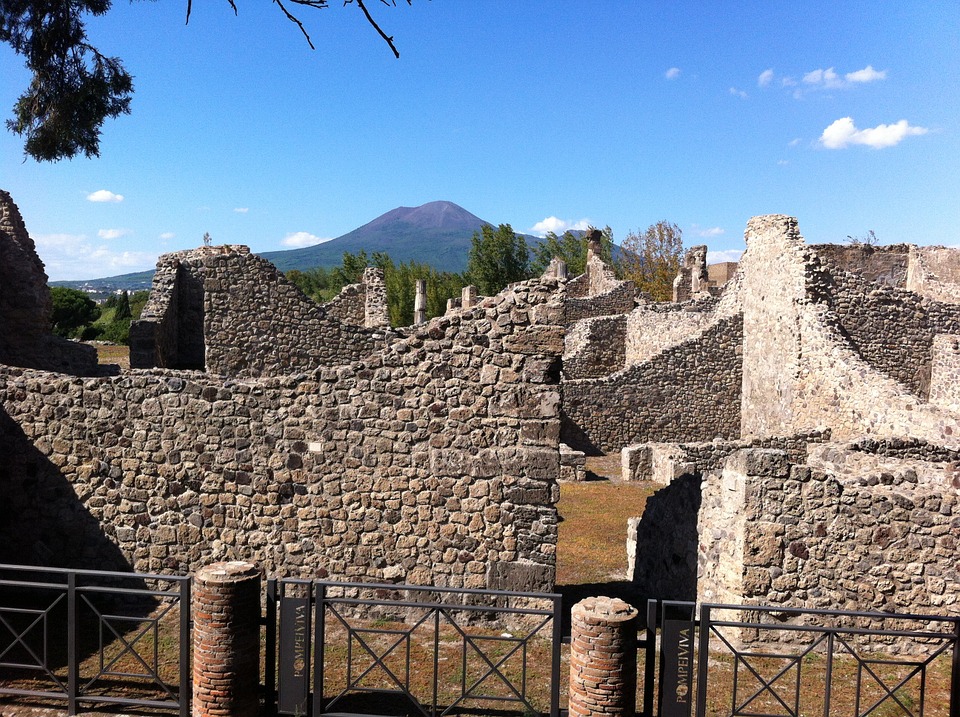
The ancient Pompeians believed that Vesuvius was a mountain. It was a surprise for them to see it break out. The event was of such importance that it was on that occasion that the ancient Romans created the word "volcano", by the divinity of the destructive fire.
9 - Pompeii possesses the oldest amphitheatre in the world
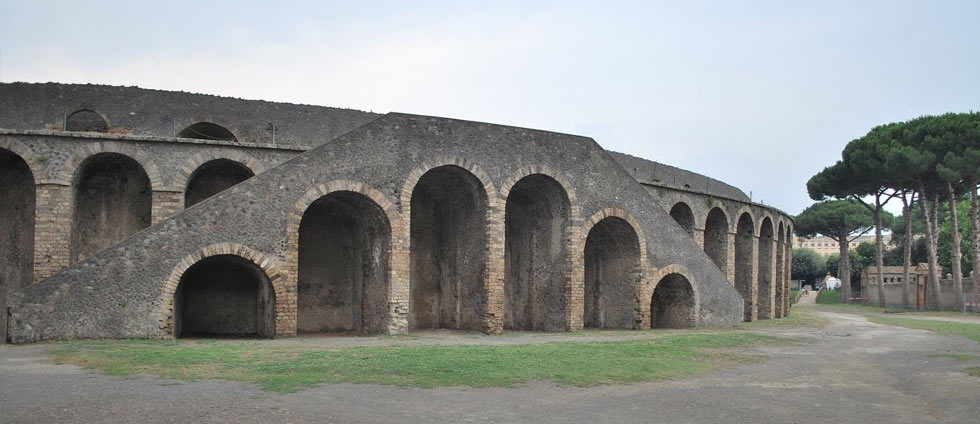
The Pompeii's amphitheatre is the oldest in the world. From 70 BC, this monument was home to great circus games as well as fights between gladiators. These events were advertised through graffiti painted on the walls of the houses.
8 - Pompeii still produces wine

Wine was one of the favorite drinks of the ancient Pompeians, to the point of appearing in many frescoes. But did you know that today, in the green areas of archaeological excavations, there are vineyards that give birth to a fragrant wine, the Villa dei Misteri?
7 - The hands of the citizens are impressed on Pompeii's fountains

Scattered in the streets of the city there are large fountains that served to refresh the citizens. On their edges, strictly in stone, you can notice grooves, signs of wear caused by the hands of those who leaned to the fountains to drink.
6 - Pompeii owns 25 brothels
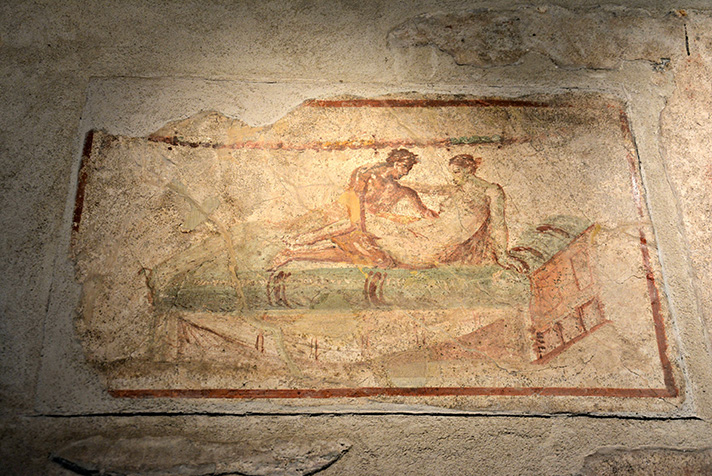
Archaeologists have discovered 25 brothels scattered all over the city. However the largest, as well as preserved, is the Lupanare. The name comes from "lupa" (she-wolf), which in the slang of the time meant "prostitute". Inside there are several erotic frescoes that archaeologists think to be a sort of red-light menu for brothels's goers.
5 - Pompeii gave its name to a color
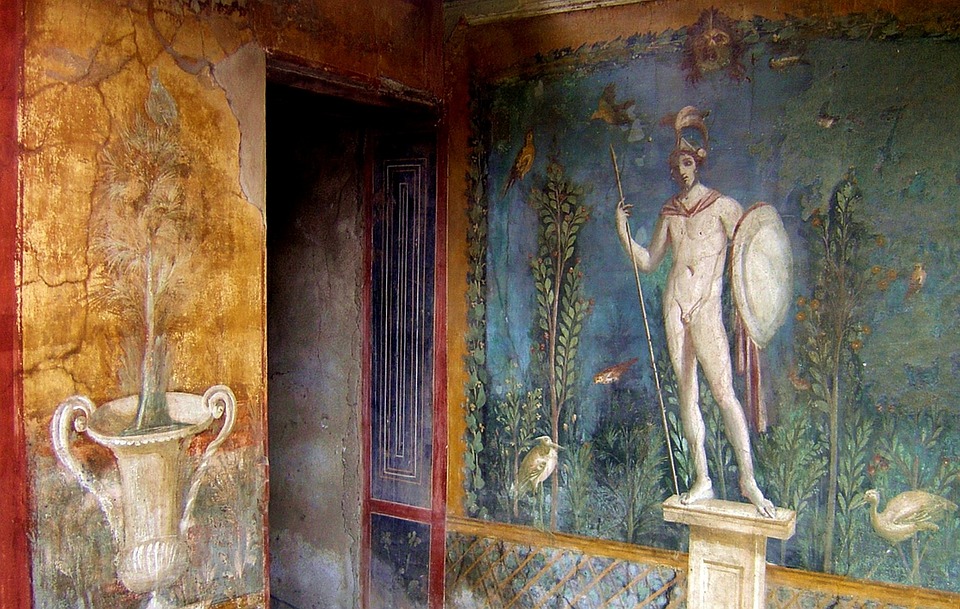
There is a color that was very used in Pompeii: the red. Pompeian red is a shade of color obtained from a special mollusc paste. Other colors used in the city are the blue and the black, lavishly rich because they are made of precious stones.
4 - In Pompeii you can see the ancient citizens
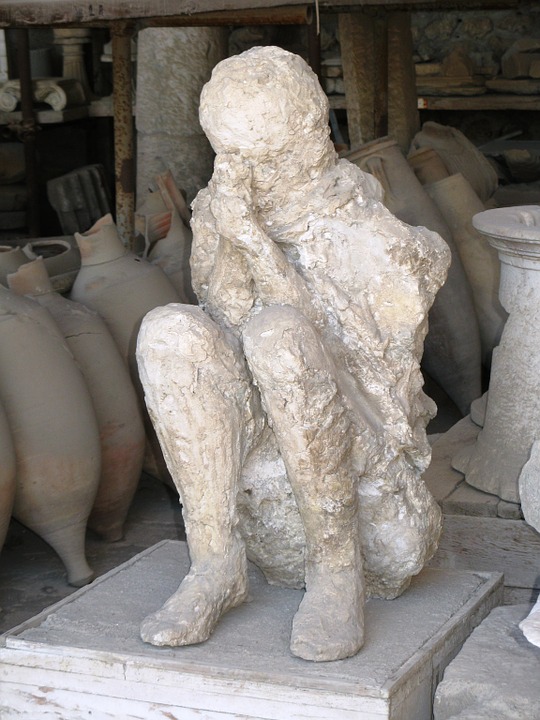
Pompeii boasts a thousand casts, authentic photographs of the ancient Pompeians in the act of dying. These finds are very important because they show us how they were doing and what they used to wear in the place 2,000 years ago. The most famous casts are those of the two lovers embraced, who inspired the movie "Pompeii" by Anderson. However recent studies have found that the two lovers were men and not a man and a woman, as in the movie.
3 - Pompeii is scattered with propitiatory flaws
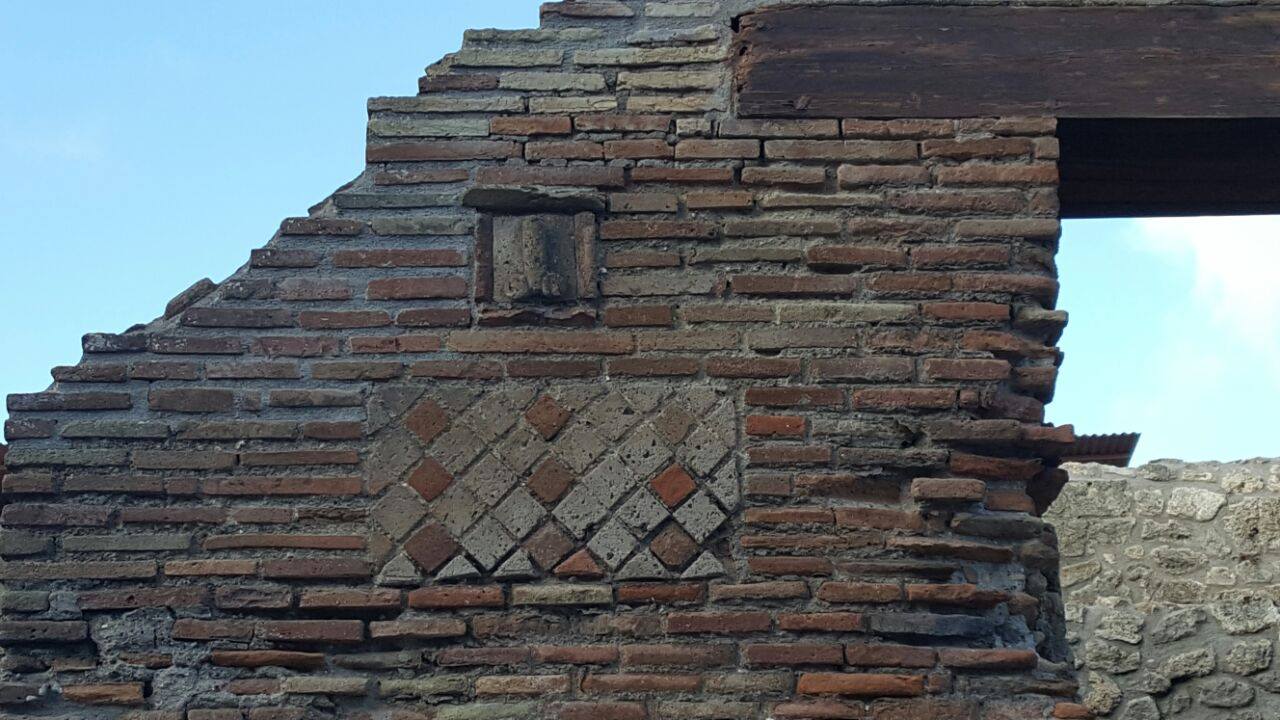
For the ancient Pompeians the foul was a mighty lucky charm and was often brought to the neck as a pendant, depicted in frescoes and engraved on the houses. In the House of Vettii, for example, there is a precious fresco depicting Priapo with a big foul, a symbol of luck.
2 - The prophetic divinity of Pompeii is Venus, the goddess of beauty
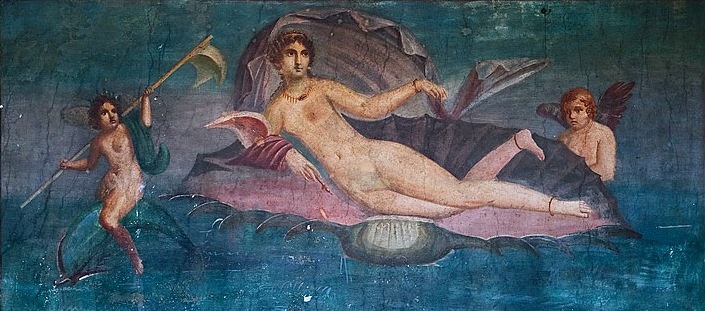
The patron saint of Pompeii is Venus, the goddess of beauty and love. In her honor, the most sumptuous temple of the city was built in a panoramic position on the Gulf of Naples. The temple, dating to the 1st century BC, is still to be visited, although lacking in original marble decorations.
1 - In Pompeii walls speak!
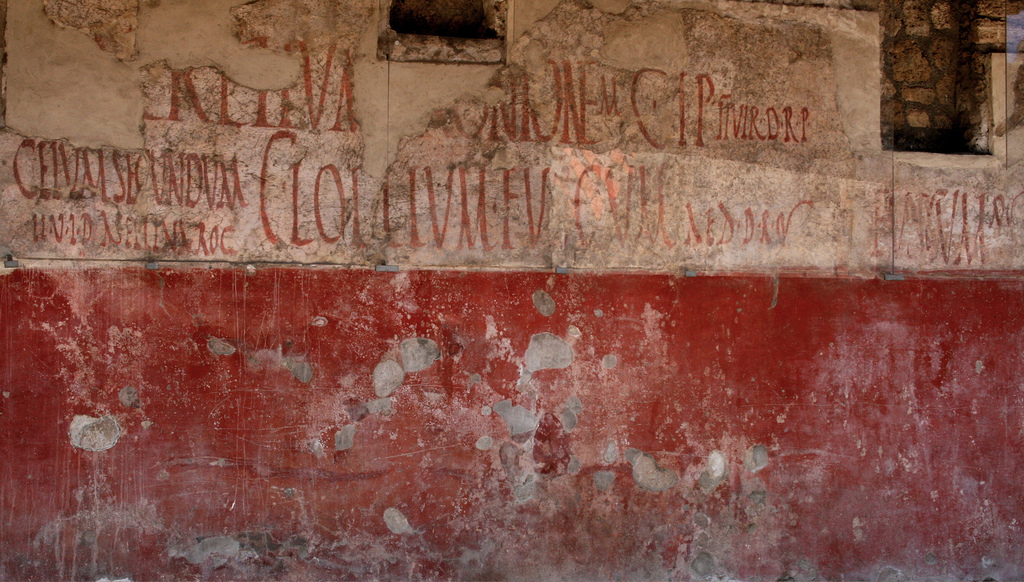
There are numerous graffiti on the walls of Pompeii, tangible testimonies of everyday life of the citizens. These are often electoral posters, in which the names of candidates were written with their slogans but also love phrases. One of the most famous: "Lovers, like bees, spend a sweet life like honey."
Is Hotel Not Hotel a hotel? Or is it one of Amsterdam’s newest restaurant and bar hot spots? You decide! Autore della citazione

Los Angeles
LA is always so much fun!

La Pizza migliore del mondo

Ti consigliamo
Lascia un commento.

Scopri subito come risparmiare!
We finally know how cockroaches conquered the world
A new study traces the German cockroach’s evolution throughout human history, from the Islamic empires to modern-day Europe.

If you’ve ever gotten up for a midnight snack and flicked on the kitchen light only to discover an army of shiny brown insects zipping beneath your fridge, then you already know the German cockroach .
Despite their name, German cockroaches now inhabit every continent except Antarctica. In fact, scientists consider the species, Blattella germanica , to be the most prevalent of the 4,600 cockroach species on Earth.
Which is surprising, given that the animals were basically unknown in Europe until Swedish biologist Carl Linnaeus first described them in 1767. That and the fact that they have no close relatives there, nor does the species exist in the wild.
So how did everyone’s least favorite houseguest become a pest of global infamy? According to a new study, the answer is written in the German cockroach’s DNA.
By analyzing genome-wide markers of 281 cockroaches from 17 countries across six continents and measuring how closely those animals were related, scientists have for the first time traced the German cockroach’s rapid rise and spread.
All signs point to the species evolving from the Asian cockroach ( Blattella asahinai ) about 2,100 years ago in what is now India and Myanmar.
As the species apparently abandoned the wild for a life spent in the shadow of humans, German cockroaches appear to have arrived in the Middle East around 1,200 years ago—probably because of increased trade and military movements in the Islamic Umayyad or Abbasid caliphates, empires that once stretched from northern Africa to western Asia.
German cockroaches experienced another geographic leap when, about 390 years ago, colonial activities kicked into overdrive and the roaches found their way to Europe and, later, the rest of the world—thanks to improvements in transportation, the reach of European trade, and the advent of household heating, which allows the insects to survive the cold.
To be clear, all these movements and migrations would have been unwittingly aided by people. (Read how cockroaches have neighborhoods, too.)
“The German cockroach can’t even fly,” says Qian Tang , an evolutionary biologist at Harvard University and lead author of the study published May 20 in Proceedings of the National Academy of Sciences . “They hitchhike in human vessels around the world.”
But it wasn’t just dumb luck that allowed the cockroaches to succeed.
Rather, it was the species’ unparalleled ability to adapt and evolve—something scientists are still trying to understand today, in the hopes that we might one day learn how to stop the German cockroach’s march across the planet.
The cockroach in the mirror
To get a sense of just how much German cockroaches have changed over the last two millennia, all you need to do is put them side by side with their closest living relative, the Asian cockroach.
For while the two species are still nearly identical, they couldn’t be more different in behavior.
If you ask me to name one species or organism that I respect the most, it’s probably the German cockroach. Chow-Yang Lee , urban entomologist at the University of California, Riverside
Asian cockroaches fly toward light sources, while German cockroaches scurry away, says Chow-Yang Lee , an urban entomologist at the University of California, Riverside. Likewise, if you toss the two species into the air, the Asian roaches take wing, while German cockroaches hit the ground running, he says.
“We have long suspected that the Asian cockroach is actually the ancestor for the German cockroach, but this paper pretty much nails it,” says Lee, who was not affiliated with the new study. “It’s extremely exciting.”
The study also revealed that German cockroach genetics reflect human relationships.
For instance, German cockroaches in Singapore and Australia are actually more closely related to their cousins in the U.S. than other German cockroach populations in nearby Indonesia. This is likely because the U.S. has historically had more trade with Singapore and Australia than Indonesia. (Read how bugs and spiders keep New York City clean by eating trash.)
“It's a beautiful example of the link between human activities, commerce, wars, colonization, and the spread of a well-adapted domiciliary pest,” study co-author Coby Schal , an urban entomologist and cockroach expert at North Carolina State University, said by email.
Gotta give some respect
German cockroaches outcompete other cockroaches everywhere they go, says Tang.
One reason for the species’ success is a faster reproductive rate than most other cockroach species, he says, which allows the animals to rapidly develop resistance to pesticides.
Earlier work by Schal’s lab revealed that after years of luring cockroaches to eat glucose-soaked poison, the population that survived sugary baits yielded a new breed of cockroaches that rejected sweets altogether. (Learn more why pesticides only make cockroaches stronger.)
“It’s just unthinkable,” says Lee. “Glucose is such an important metabolic fuel for all organisms.”
Lee says sometimes he and his colleagues will be working on a new, anti-roach compound that hasn’t even been released for commercial use yet, but by the time they test it on cockroaches in a lab, the animals are already resistant.
And that, combined with the wonders of modern transportation, lead him to have very little hope that humans will find a way to beat back cockroach infestations anytime soon.
“If you ask me to name one species or organism that I respect the most, it’s probably the German cockroach,” Lee says.
For Hungry Minds
Related topics.
- COCKROACHES
- HISTORY AND CIVILIZATION
- MODERN HISTORY
You May Also Like

We still don't know why humans started drinking cow's milk
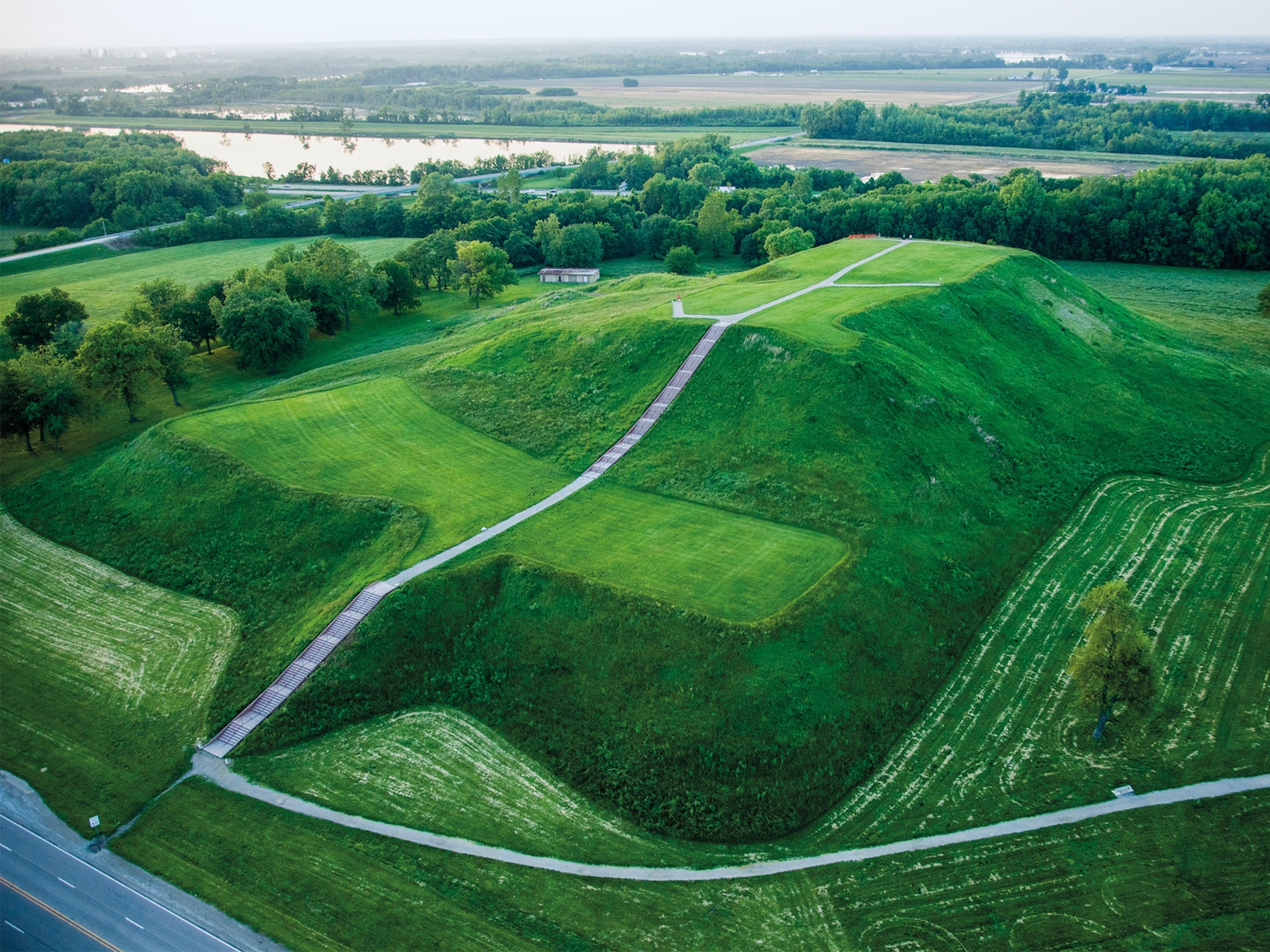
This American Indian metropolis was mysteriously abandoned. Archaeologists want to know why.

How Humans Are Shaping Our Own Evolution

How this artist created 1 stunning work of art, from 200 years of discoveries

Roach, Worms, and Hippo: How these 8 towns got their unusual names
- Paid Content
- Environment
- Photography
- Perpetual Planet
History & Culture
- History & Culture
- History Magazine
- Mind, Body, Wonder
- World Heritage
- Terms of Use
- Privacy Policy
- Your US State Privacy Rights
- Children's Online Privacy Policy
- Interest-Based Ads
- About Nielsen Measurement
- Do Not Sell or Share My Personal Information
- Nat Geo Home
- Attend a Live Event
- Book a Trip
- Inspire Your Kids
- Shop Nat Geo
- Visit the D.C. Museum
- Learn About Our Impact
- Support Our Mission
- Advertise With Us
- Customer Service
- Renew Subscription
- Manage Your Subscription
- Work at Nat Geo
- Sign Up for Our Newsletters
- Contribute to Protect the Planet
Copyright © 1996-2015 National Geographic Society Copyright © 2015-2024 National Geographic Partners, LLC. All rights reserved

IMAGES
VIDEO
COMMENTS
Pompeii was an ancient city in southern Italy. In ad 79 a volcano called Mount Vesuvius erupted close by. Thousands of people died, and the city was buried. Archaeologists later cleared away much of the rubble. They uncovered ruins that gave historians a look at life in the Roman Empire .
The eruption happened the day after the religious festival of Vulcan, who was the Roman god of fire. Pompeii was rediscovered in 1748 when builders were constructing a palace for King Charles III. Pompeii is a UNESCO Heritage Site, which means it is protected and preserved. Mount Vesuvius erupted most recently in 1944, but it wasn't as ...
Pompeii was destroyed—together with Herculaneum, Stabiae, Torre Annunziata, and other communities—by the violent eruption of Mount Vesuvius in ad 79. The remains of these cities have been preserved and serve as a unique document of Greco-Roman life. ... Improved homework resources designed to support a variety of curriculum subjects and ...
The city of Pompeii is famous because it was destroyed in 79 CE when a nearby volcano, Mount Vesuvius, erupted, covering it in at least 19 feet (6 metres) of ash and other volcanic debris.The city's quick burial preserved it for centuries before its ruins were discovered in the late 16th century. The subsequent excavation of Pompeii and the surrounding areas in the mid-18th century marked ...
The city of Pompeii was a popular vacation destination for the Romans. It is estimated that between 10,000 and 20,000 people lived in the city. Many wealthy Romans had summer homes in Pompeii and would live there during the hot summer months. Pompeii was a typical Roman city. On one side of the city was the forum.
Pompeii, a flourishing resort city south of ancient Rome, was nestled along the coast of Italy in the shadow of Mount Vesuvius, an active volcano. Its most famous eruption took place in the year ...
Pompeii is a preserved ancient Roman city in Campania, Italy, 14 miles (23 km) southeast of Naples, at the southeastern base of Mount Vesuvius. It was built on a spur formed by a prehistoric lava flow to the north of the mouth of the Sarnus (modern Sarno) River. Pompeii was destroyed, together with Herculaneum, Stabiae, Torre Annunziata, and ...
Pompeii was a large Roman town in Campania, Italy which was buried in volcanic ash following the eruption of Mt. Vesuvius in 79 CE. Excavated in the 19th-20th century, its excellent state of preservation gives an invaluable insight into Roman everyday life. Pompeii is perhaps the richest archaeological site in the world for the volume of data available to scholars.
Pompeii (/ p ɒ m ˈ p eɪ (i)/ pom-PAY-(ee), Latin: [pɔmˈpei̯.iː]) was an ancient city in what is now the comune (municipality) of Pompei, near Naples, in the Campania region of Italy.Along with Herculaneum, Stabiae, and many surrounding villas, the city was buried under 4 to 6 m (13 to 20 ft) of volcanic ash and pumice in the eruption of Mount Vesuvius in 79 AD.
One of the best known ancient sites in the world, Pompeii was an ancient Roman city founded in the 6th to 7th century BC and famously destroyed by the eruption of the volcano Mount Vesuvius in 79 AD. History of Pompeii. It's thought Pompeii was established sometime around 450 BC. Following the Social Wars, Pompeii became a Roman colony, and quickly assimilated into the Roman world, adopting ...
June 3, 2020. Learn all about the lost city of Pompeii, one of the world's most important historical sites. Pompeii was hit by an extreme volcano eruption and stayed frozen in time for thousands of years. Once a bustling city in Italy, Pompeii was destroyed when the volcano Mount Vesuvius erupted. It was just miles away and buried the whole city.
In this lesson, students will gain an understanding of the archaeological site of Pompeii. They will develop an awareness of the key people, events, and concepts associated with this movement. Students will have the opportunity to achieve this through choosing their own method of learning, from source analysis, research, and video options, as well as the chance to engage in extension activities.
The history of Pompeii's rediscovery is as compelling as the city itself. A chance discovery during the construction of a new palace in 1748 brought the ruins to light after nearly 1700 years. This monumental finding led to extensive excavation and the emergence of advanced archaeological techniques that changed the field forever.
If you have any queries about our upcoming curriculum resource links, please email: [email protected]. This primary resource assists with teaching the following Key Stage 2 History objectives from the National Curriculum: Pupils should be taught about: the Roman Empire and its impact on Britain. And the following Key Stage 2 Geography ...
The rediscovered city of Pompeii is one of the most popular tourist attractions in Italy. The ruins of Pompeii are visited by over 2.5 million people each year. In 1997, the United Nations declared Pompeii a World Heritage Site. A World Heritage Site is any landmark or area that is considered to have cultural or historical significance.
This happened to the Roman city of Pompeii 2,000 years ago when Mount Vesuvius, a volcano near the city of Naples in Italy, erupted.While it was very bad news for the Pompeians, it was very good ...
A city forever frozen in time, Pompeii's history is a melancholy paradox. The very event that gruesomely took Pompeii — Mt. Vesuvius' eruption in 79 AD — preserved the daily comings and goings of the ancient city, allowing us to piece together its story. Excavations through history have given us touching images of an unavoidable tragedy, and reactions of the Roman people right up to ...
This fantastic KS2 The Lost City of Pompeii Fact File provides some key information about this famous ancient Roman city. Learn about the history of Pompeii, the eruption of Mount Vesuvius and how the city has been preserved. Show more. pompeii pompeii fact file romans vesuvius escape from pompeii pompeii comprehension.
Here are four top Pompeii facts for kids: At the time of Vesuvius' eruption, Pompeii had a population of 11,000 and it was believed that 2,000 people were killed. The city was abandoned afterwards and was rediscovered in 1748, where surprisingly underneath the layer of debris, Pompeii was actually intact. Pompeii is now a tourist destination ...
Pompeii is open between 9 am - 7:30 pm every Monday to Friday between 1 st April - 31 st October. It opens at 8:30 am on Saturdays and Sundays. Last admission is at 6 pm. Opening hours in winter (1 st November - 31 st March) are between 9 am to 5 pm. Last admission is at 3:30 pm.
6 - Pompeii owns 25 brothels. Archaeologists have discovered 25 brothels scattered all over the city. However the largest, as well as preserved, is the Lupanare. The name comes from "lupa" (she-wolf), which in the slang of the time meant "prostitute". Inside there are several erotic frescoes that archaeologists think to be a sort of red-light ...
Tour Pompeii ruins, House of Faun, Forum, Temple of Apollo, and Amphitheatre with Mount Vesuvius in view. Pompeii: a main street of ancient Pompeii. Pompeii: basilica. Pompeii: Temple of Apollo. This image also in: Scholars Western architecture; Apollo. This image also in: Scholars Apollo;
Volcanoes: Pompeii & Vesuvius Case Study. On the 24th of August, 79AD, people in Pompeii, Italy noticed something strange happening above their city. A huge cloud had appeared above the horizon. This wasn't any cloud, however, this was a cloud of ash and gas that had been spewed into the air by the erupting Mount Vesuvius.
A new study traces the German cockroach's evolution throughout human history, from the Islamic empires to modern-day Europe. The German cockroach (above) likely evolved from the Asian cockroach ...